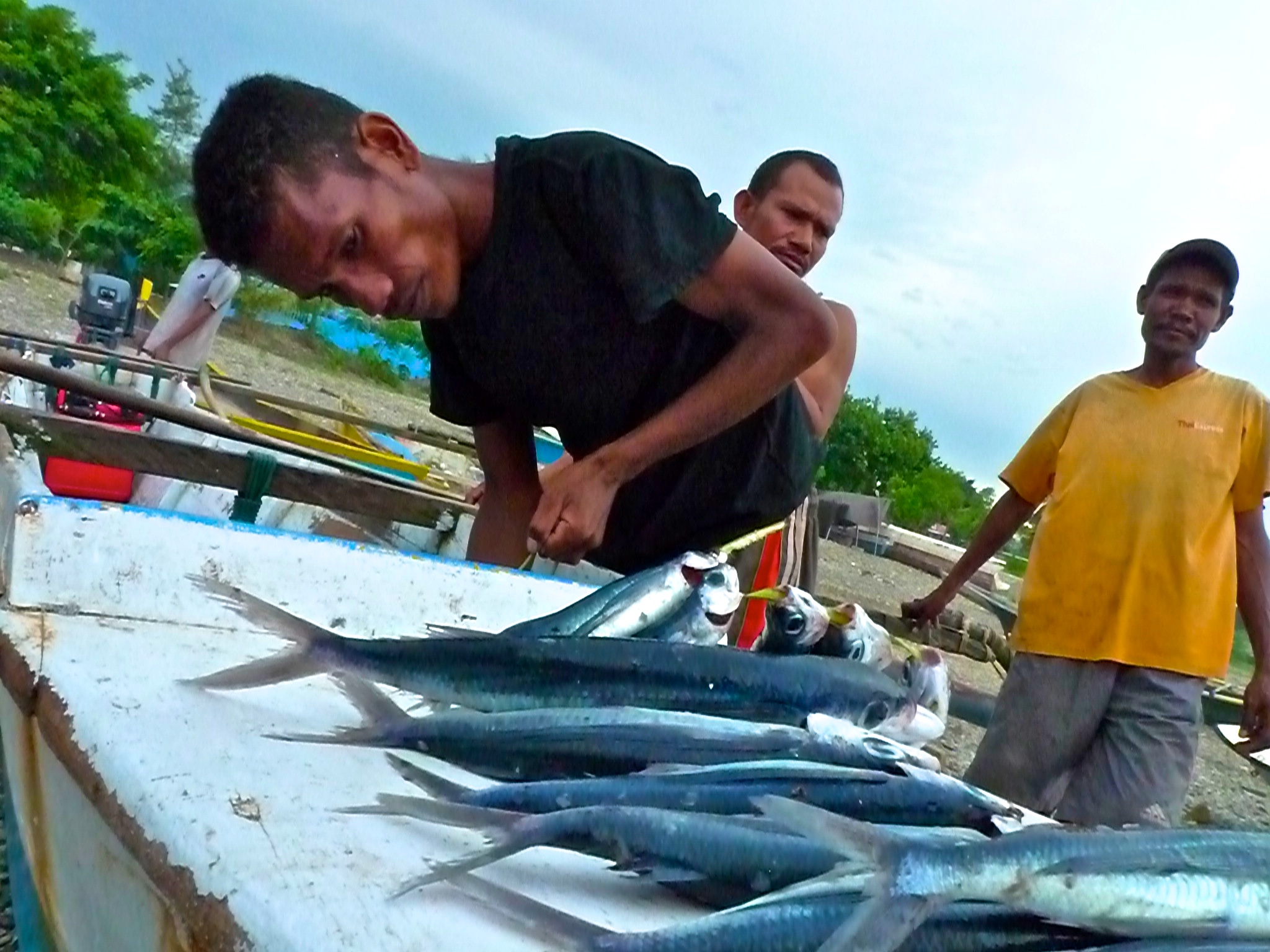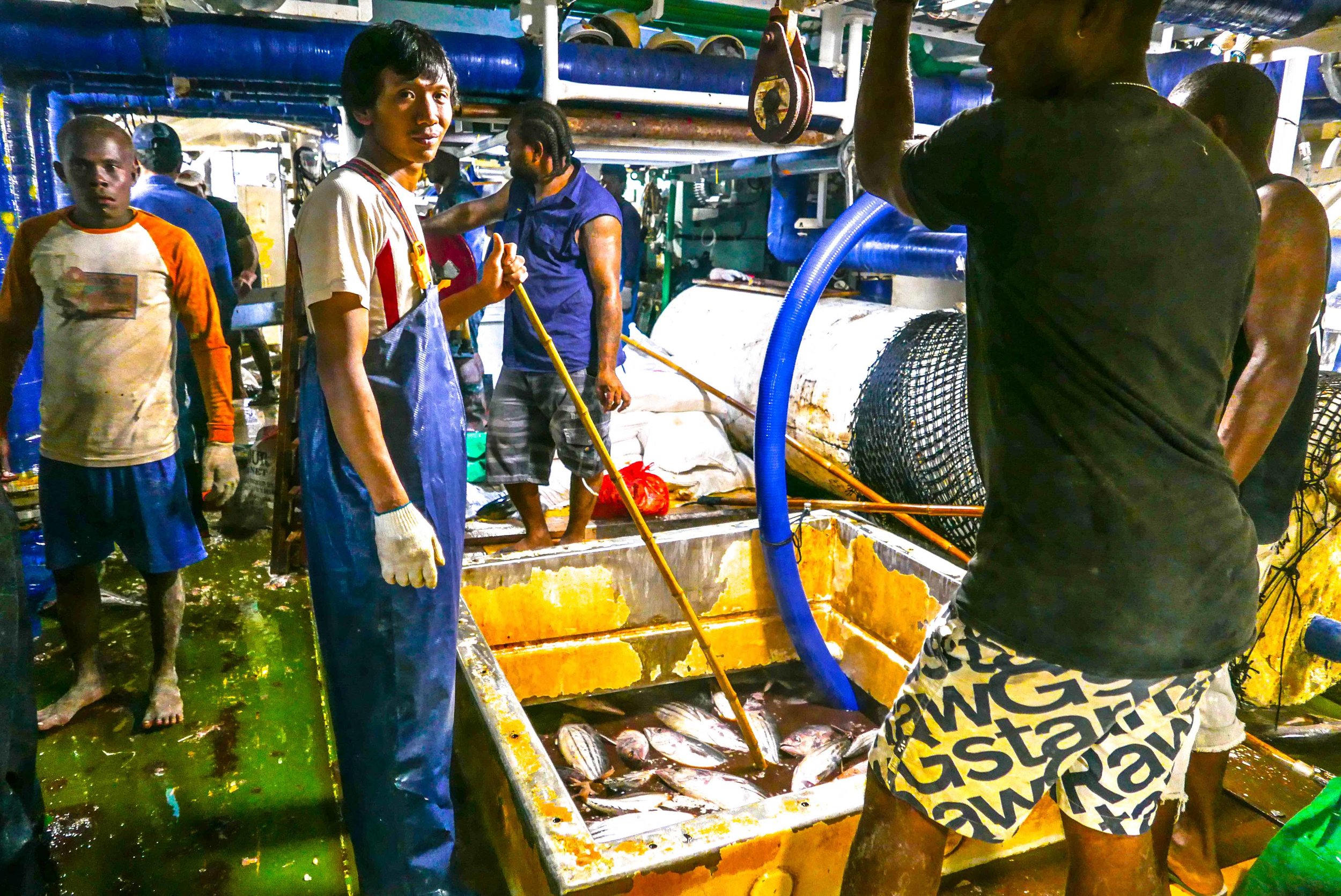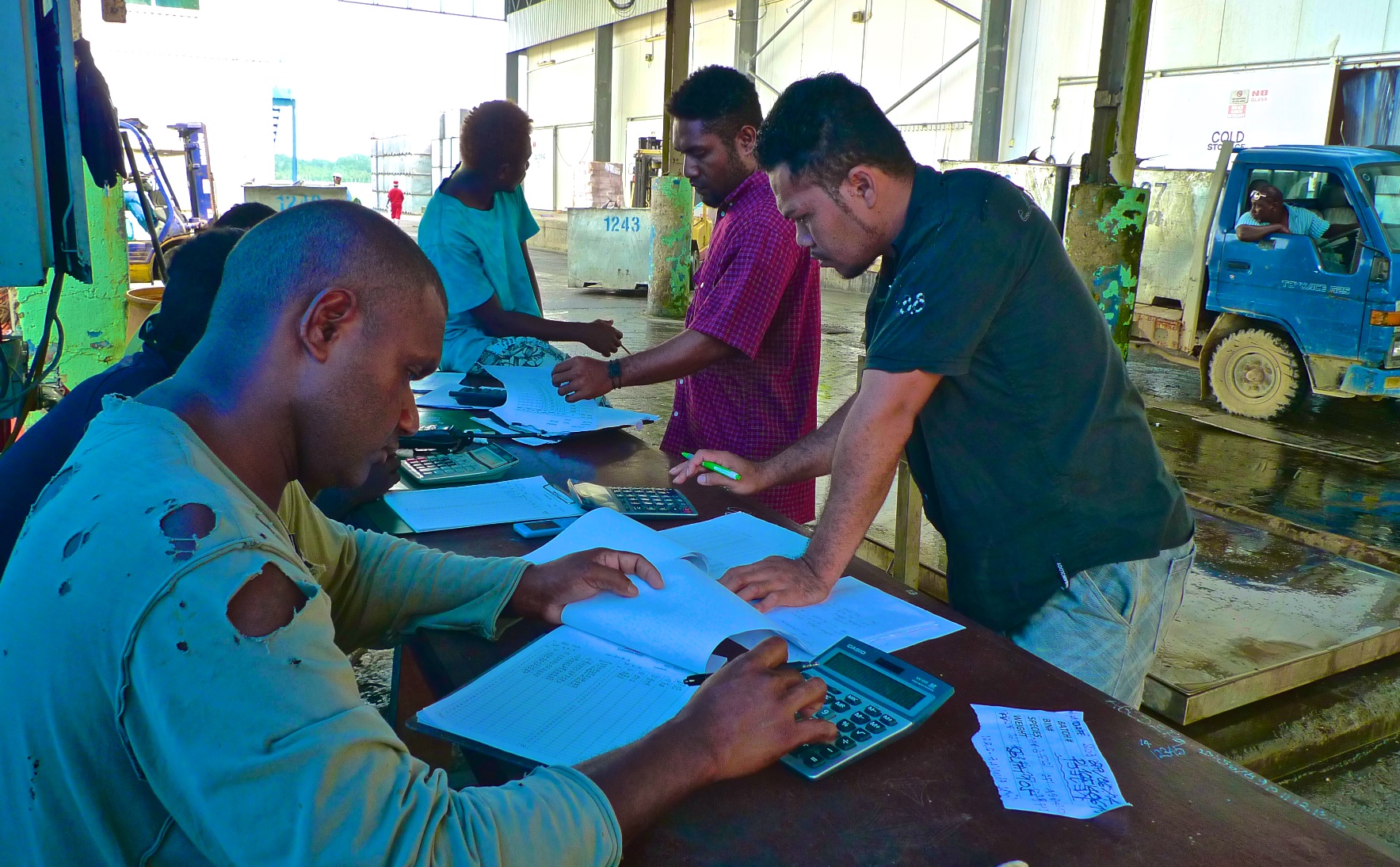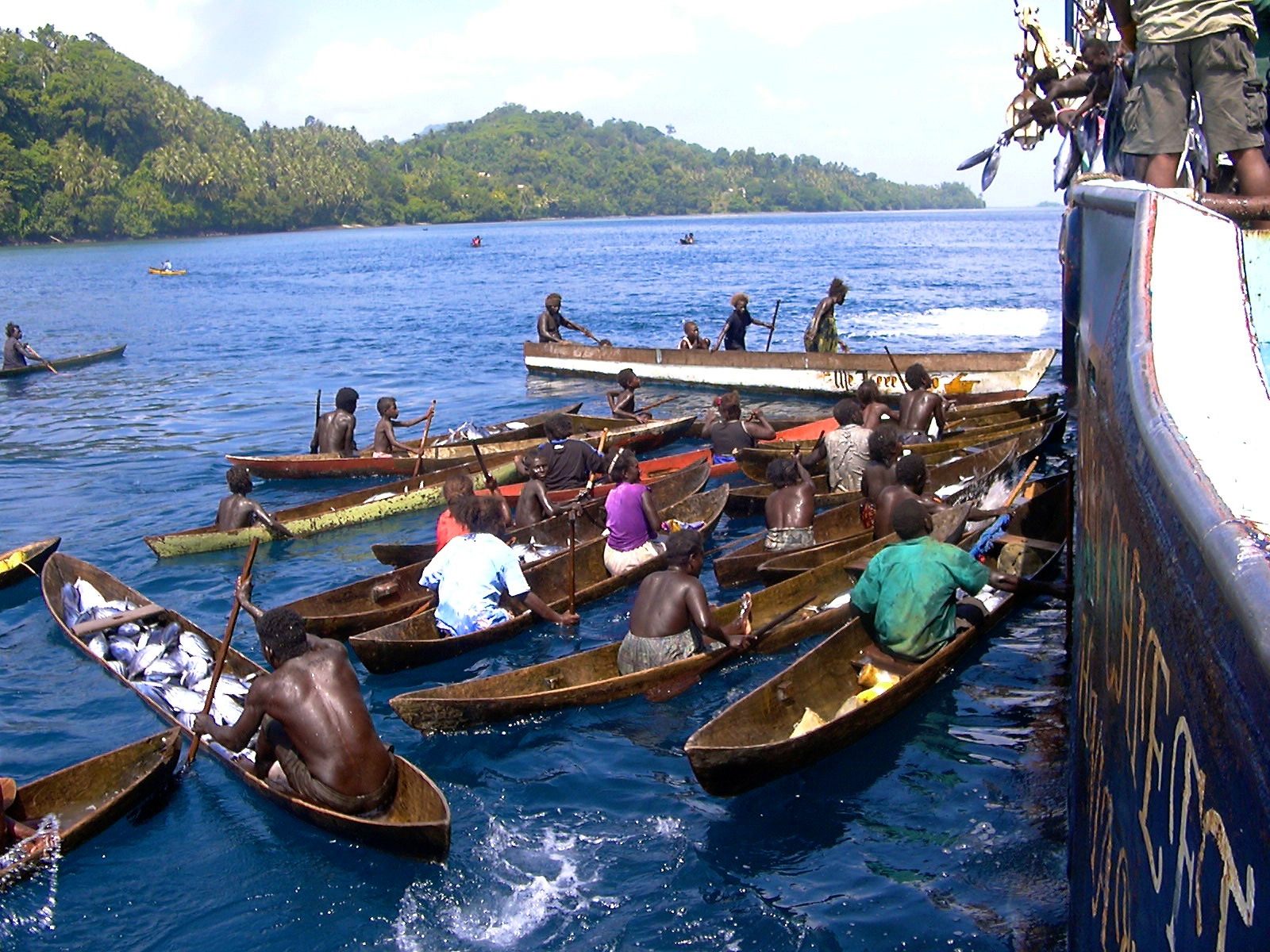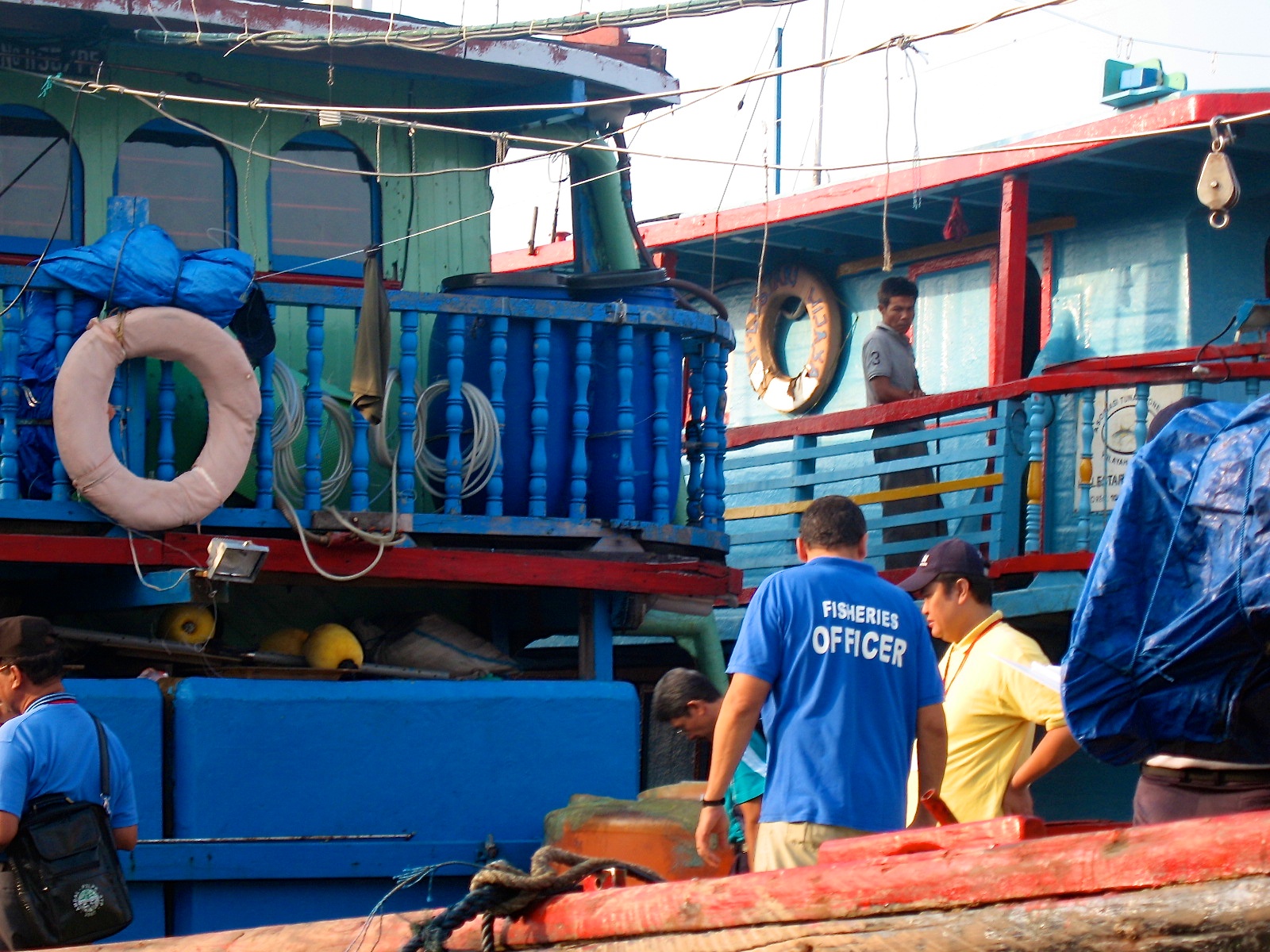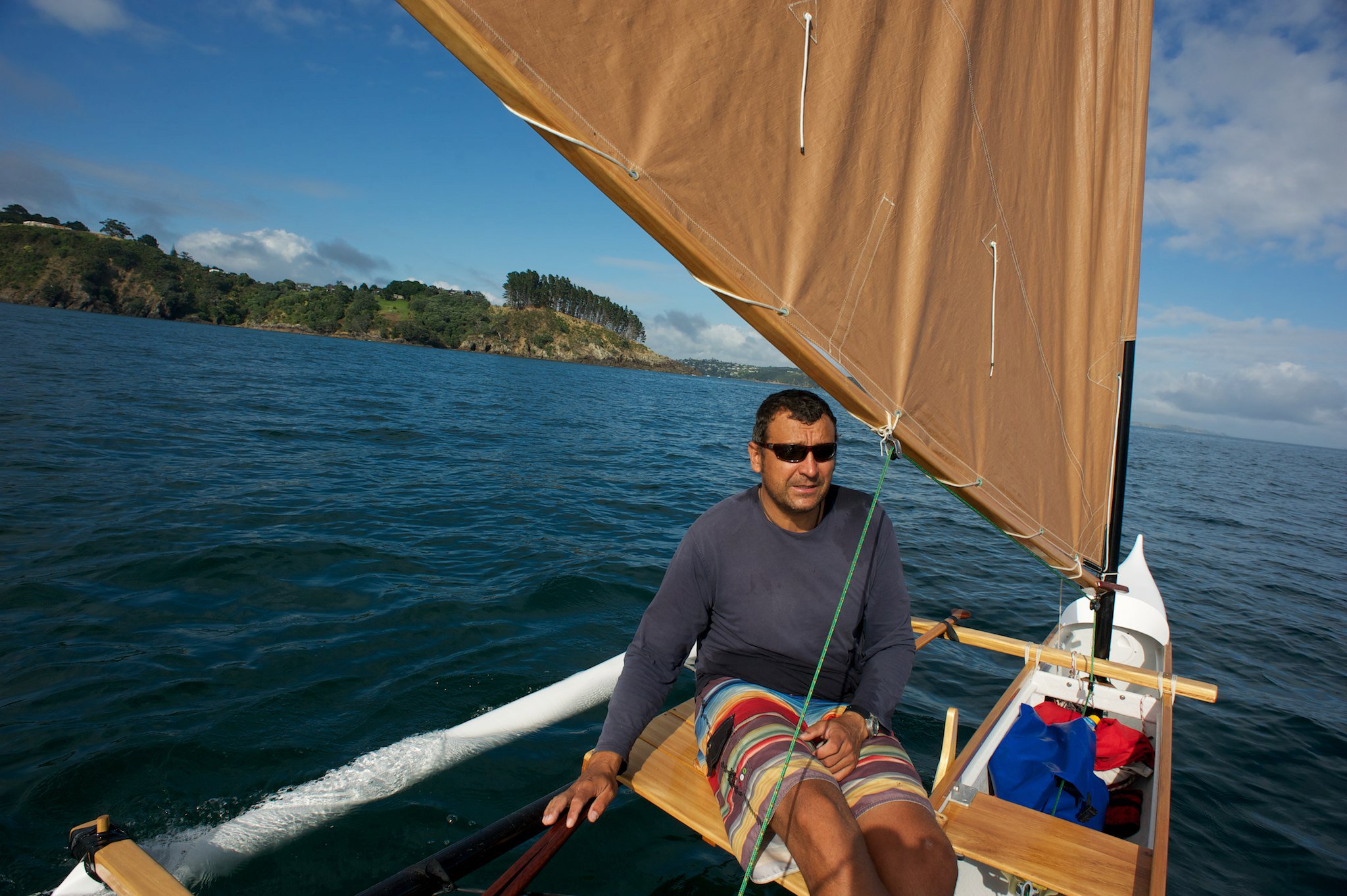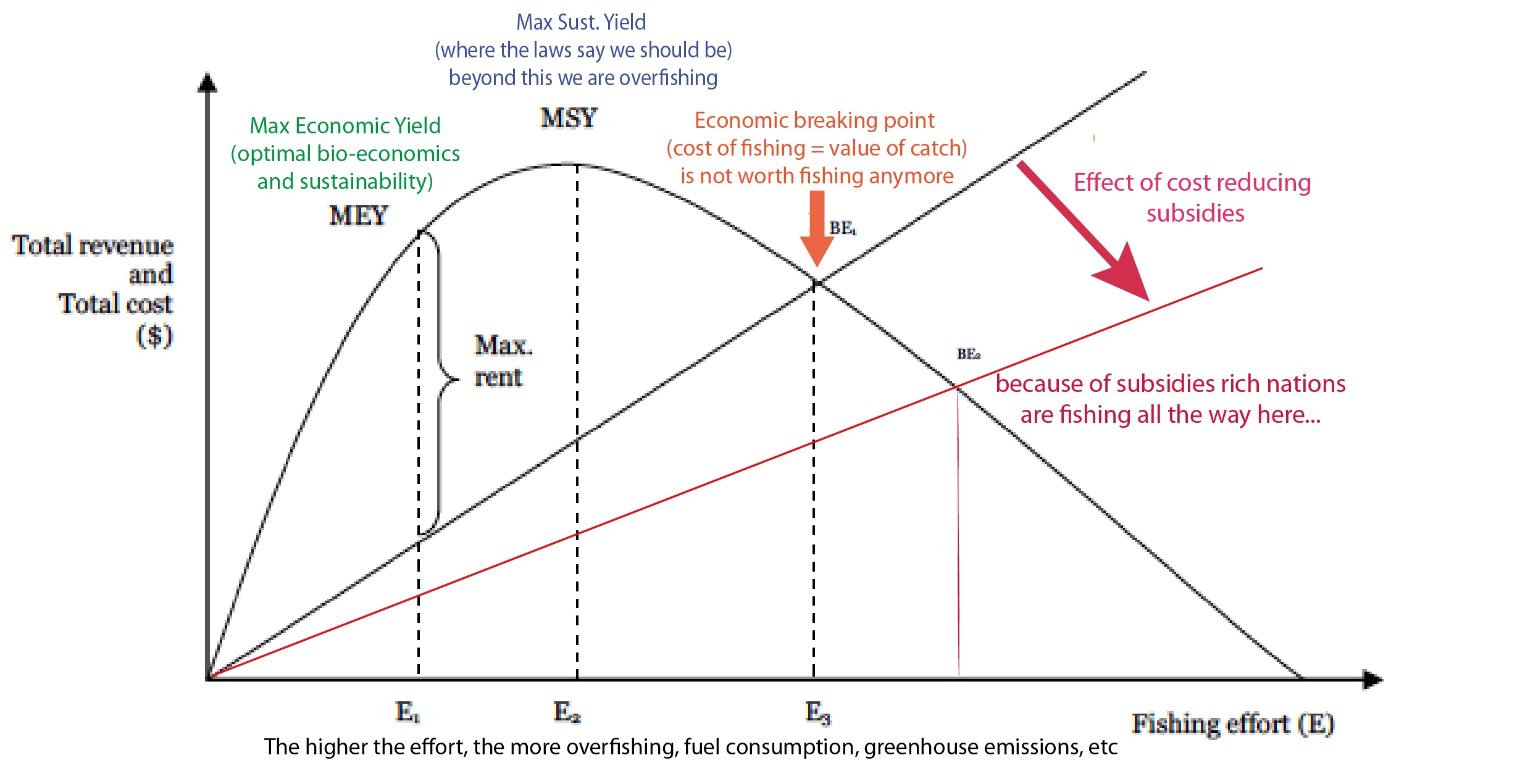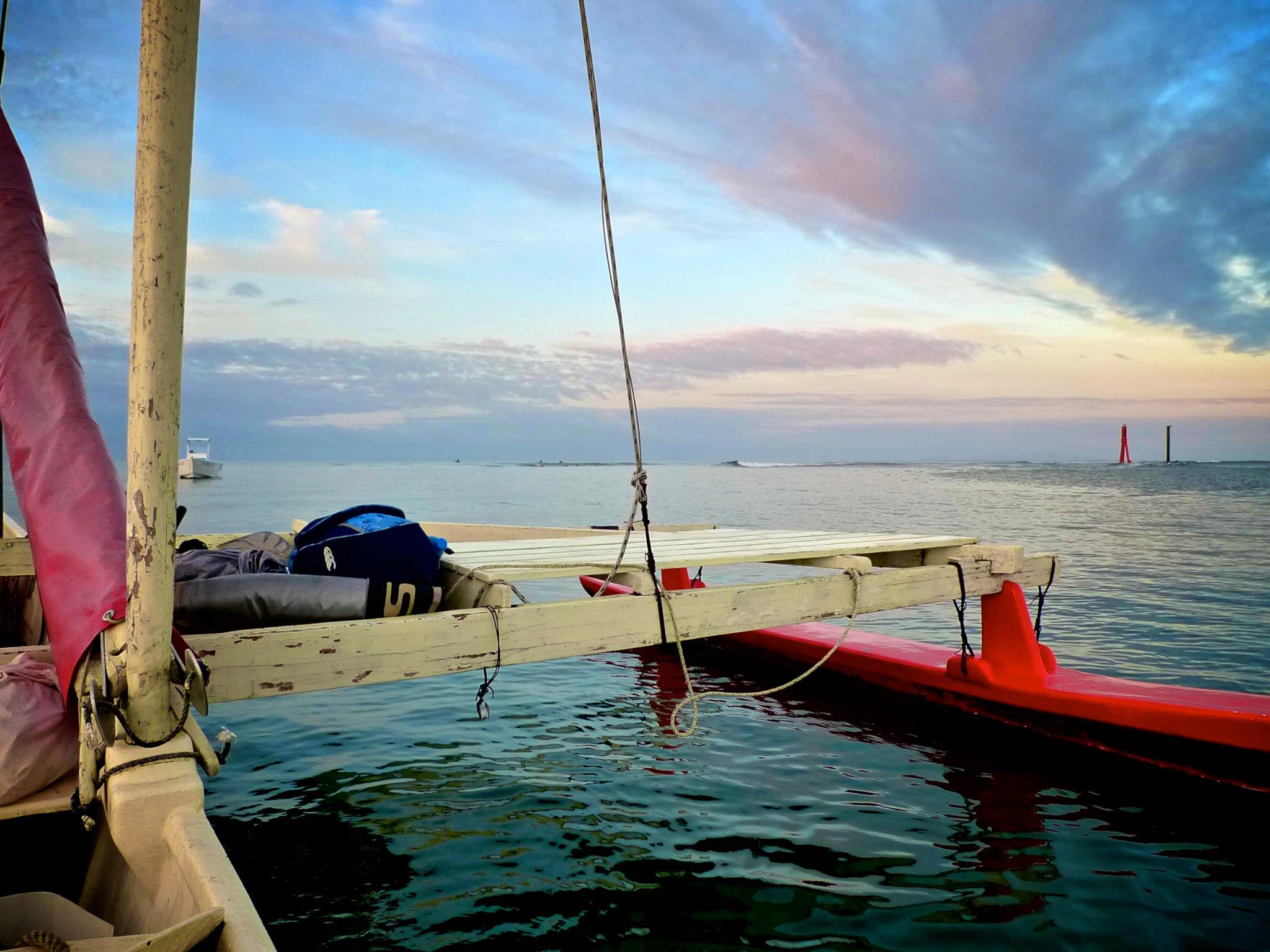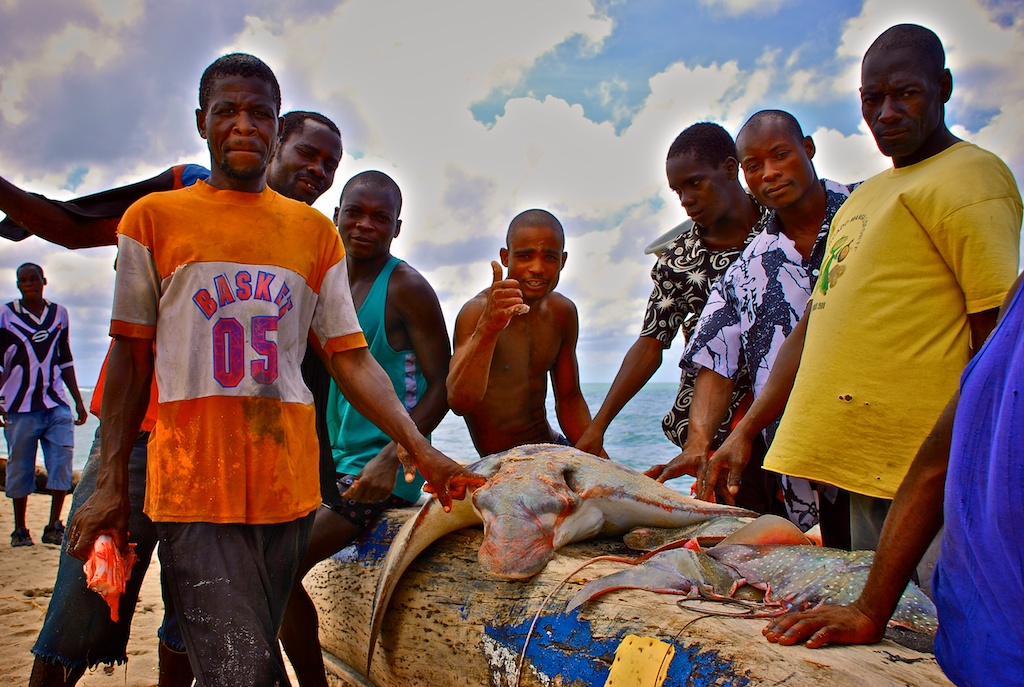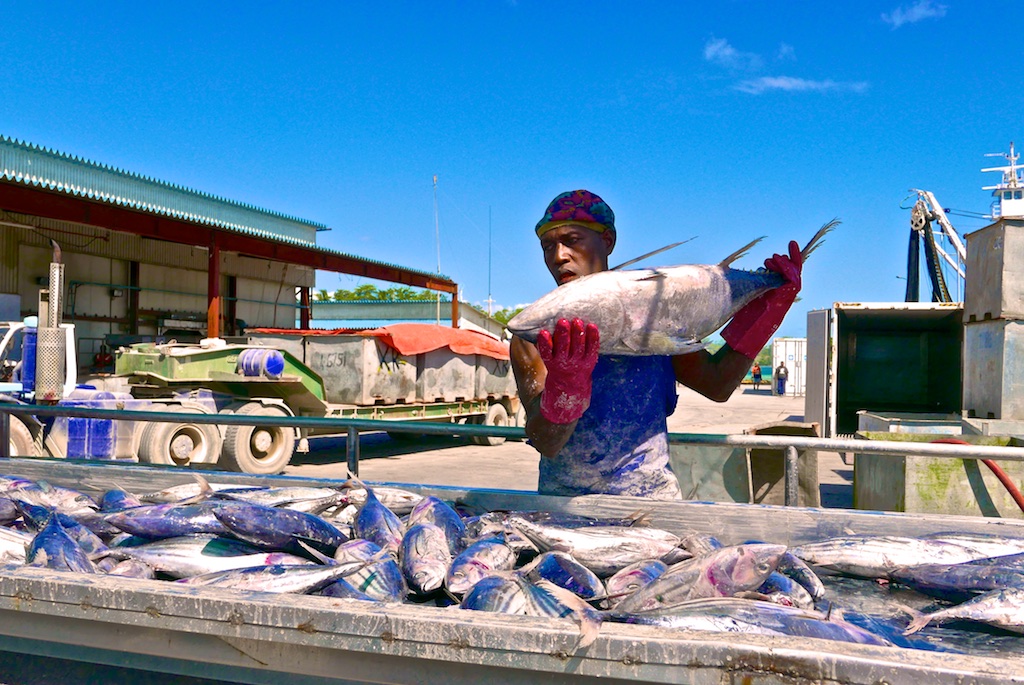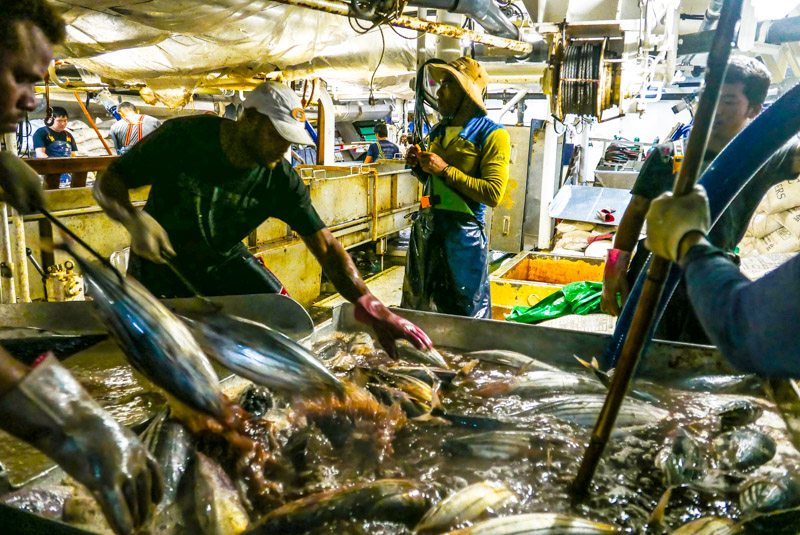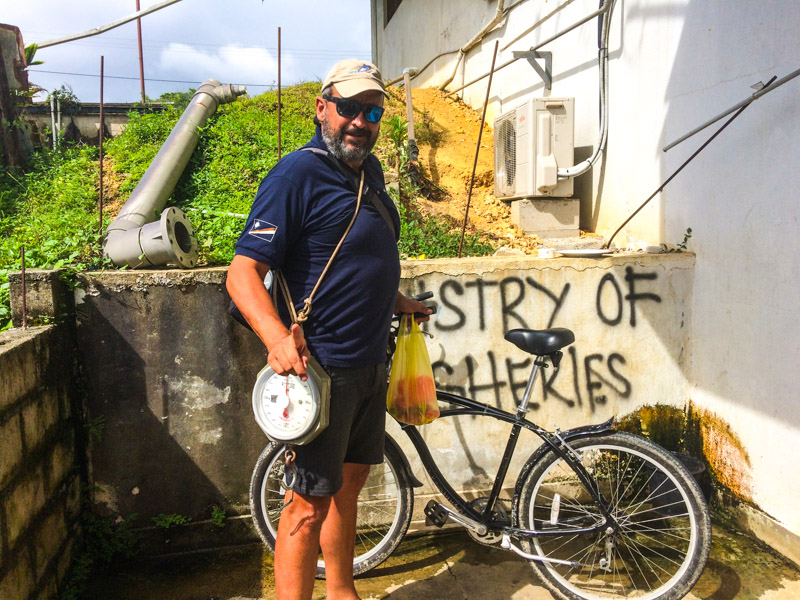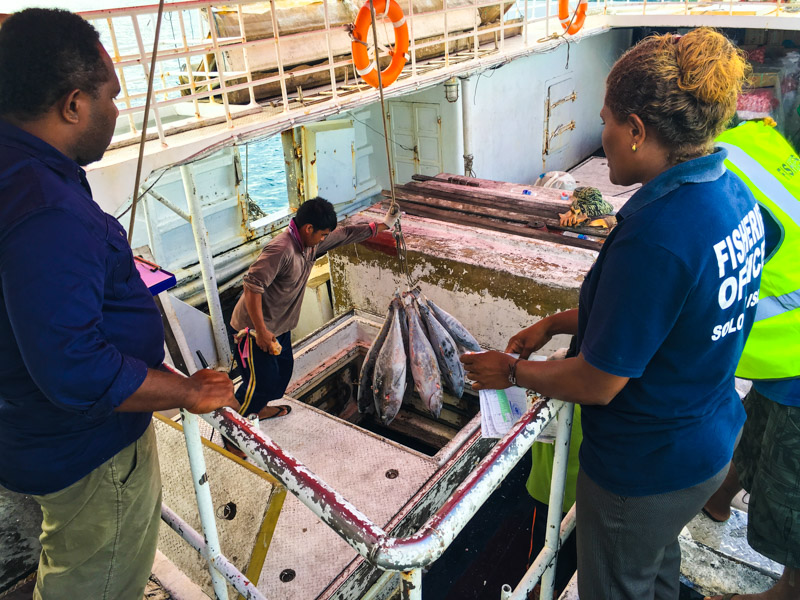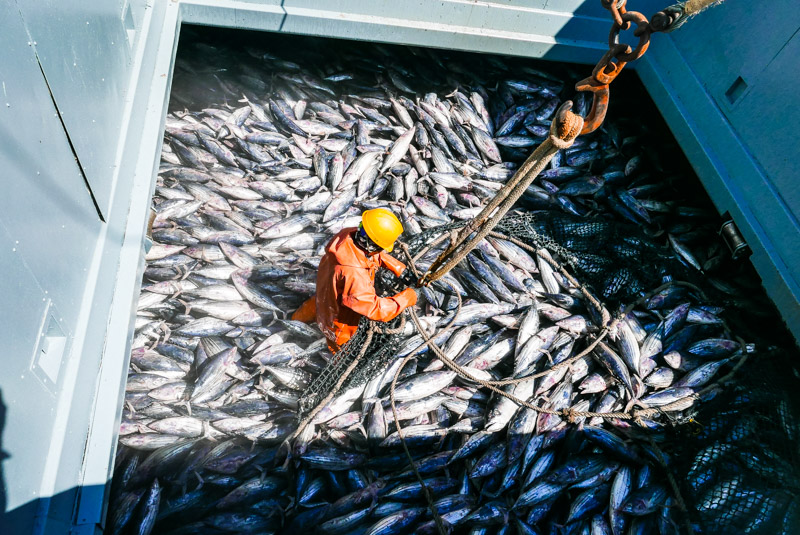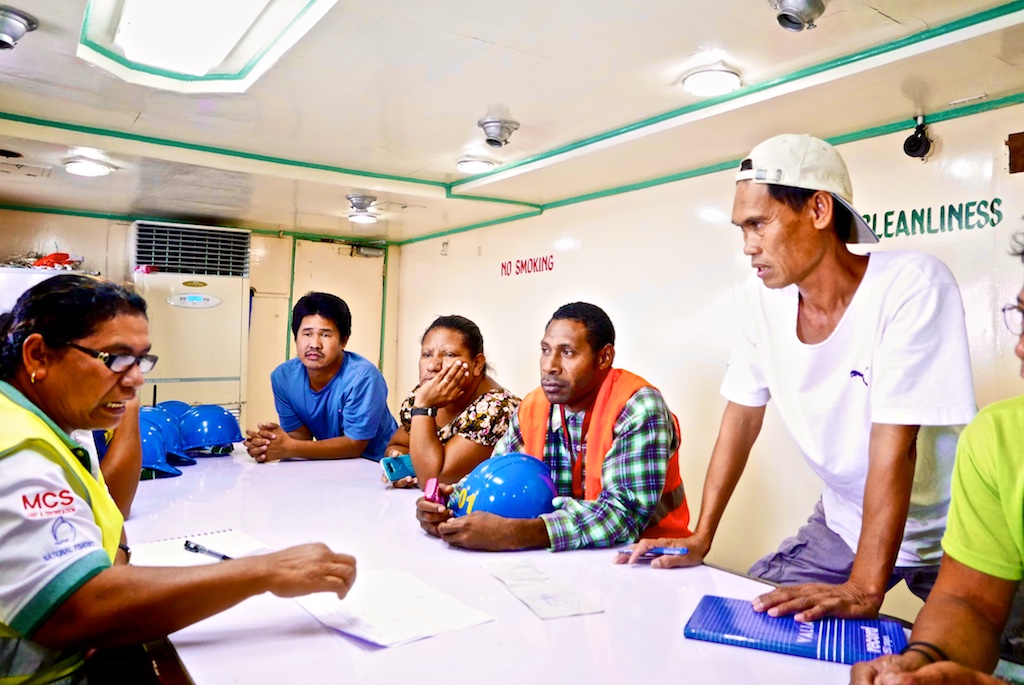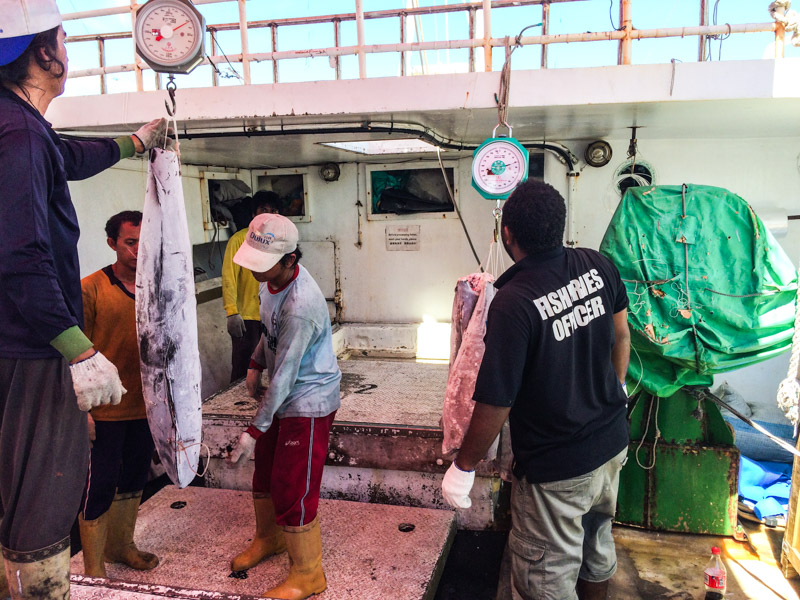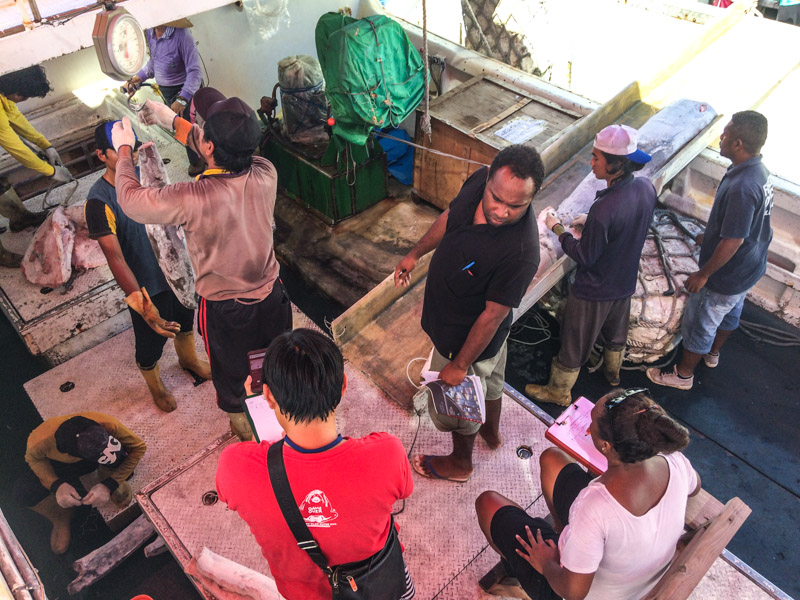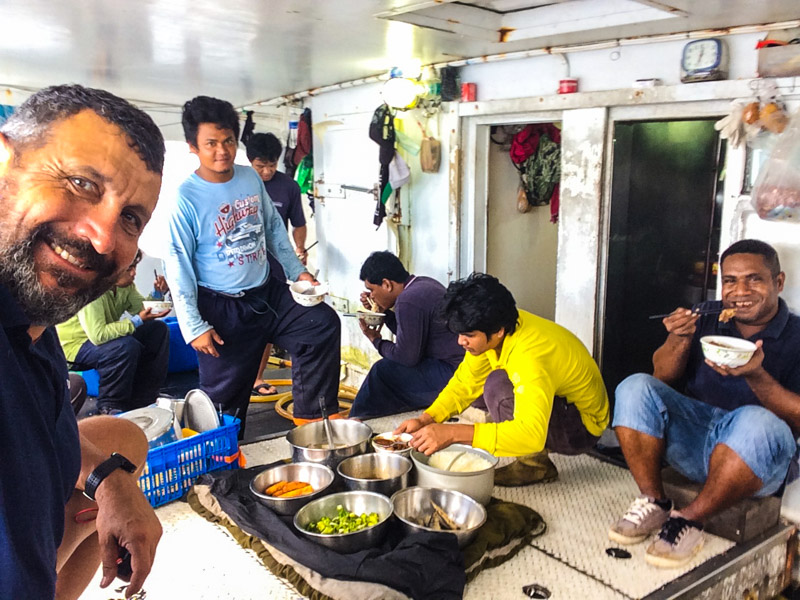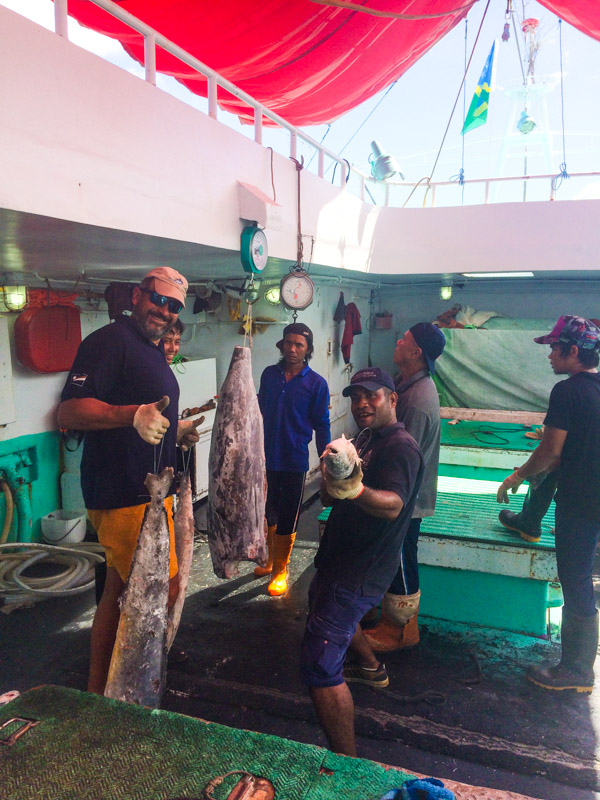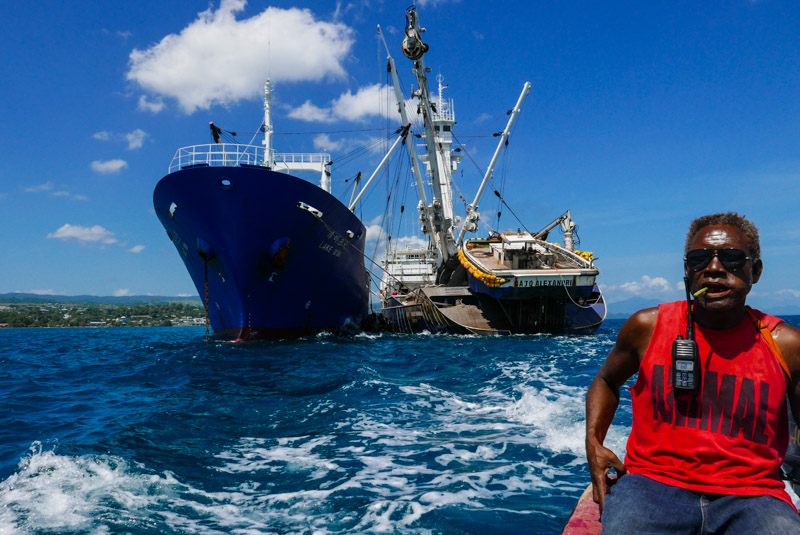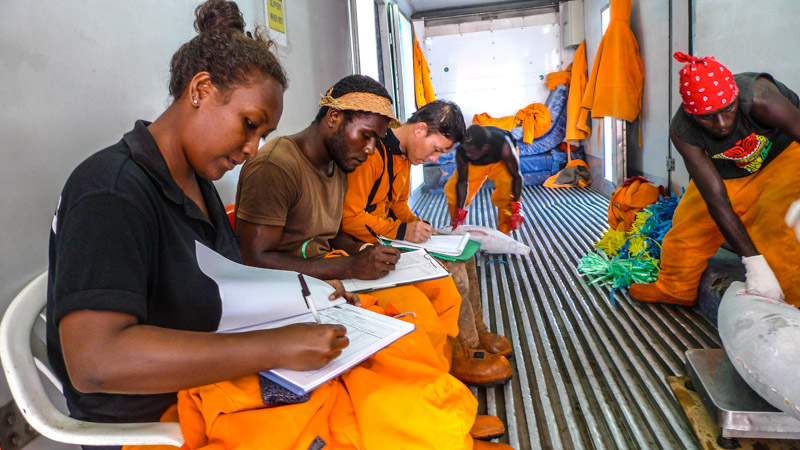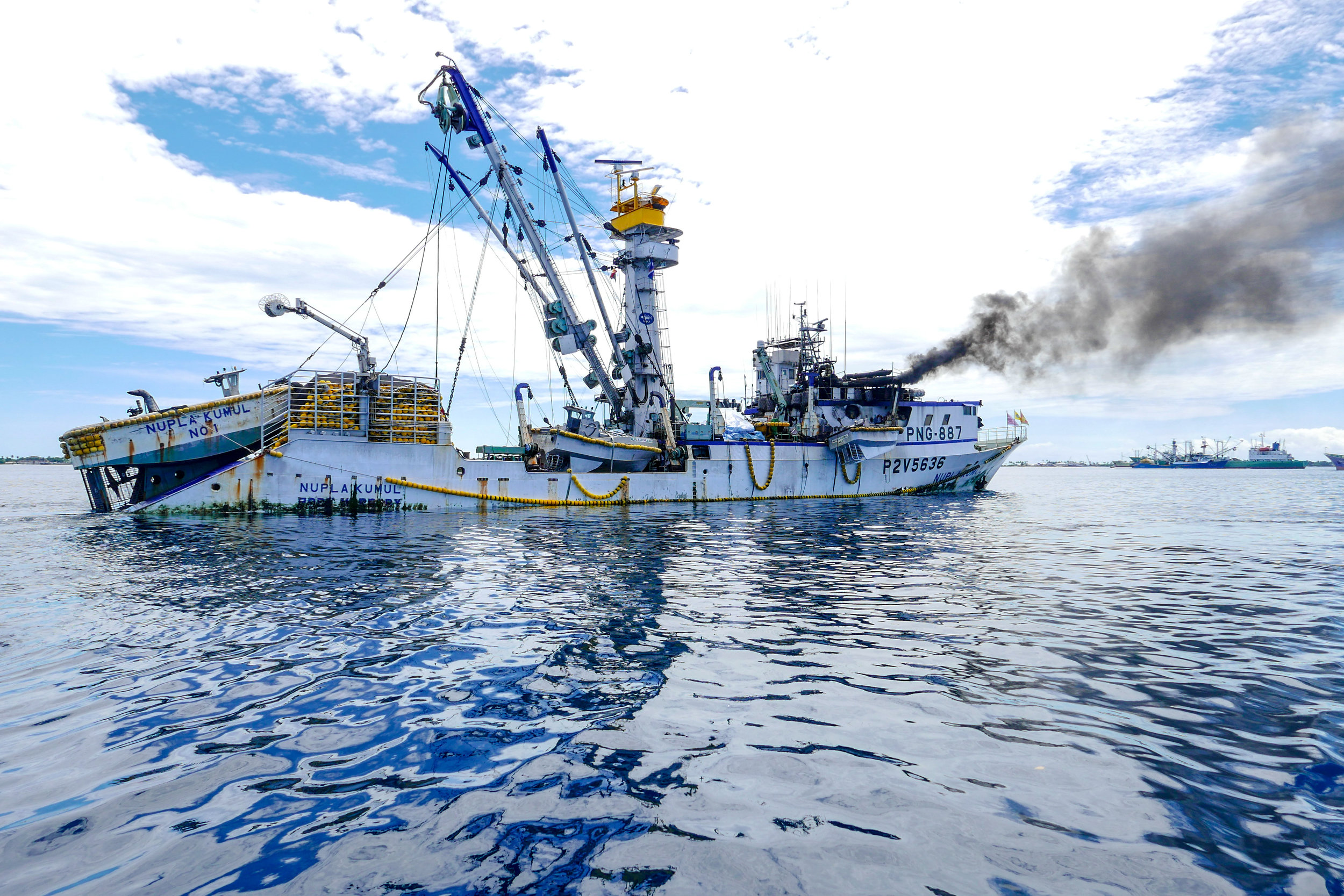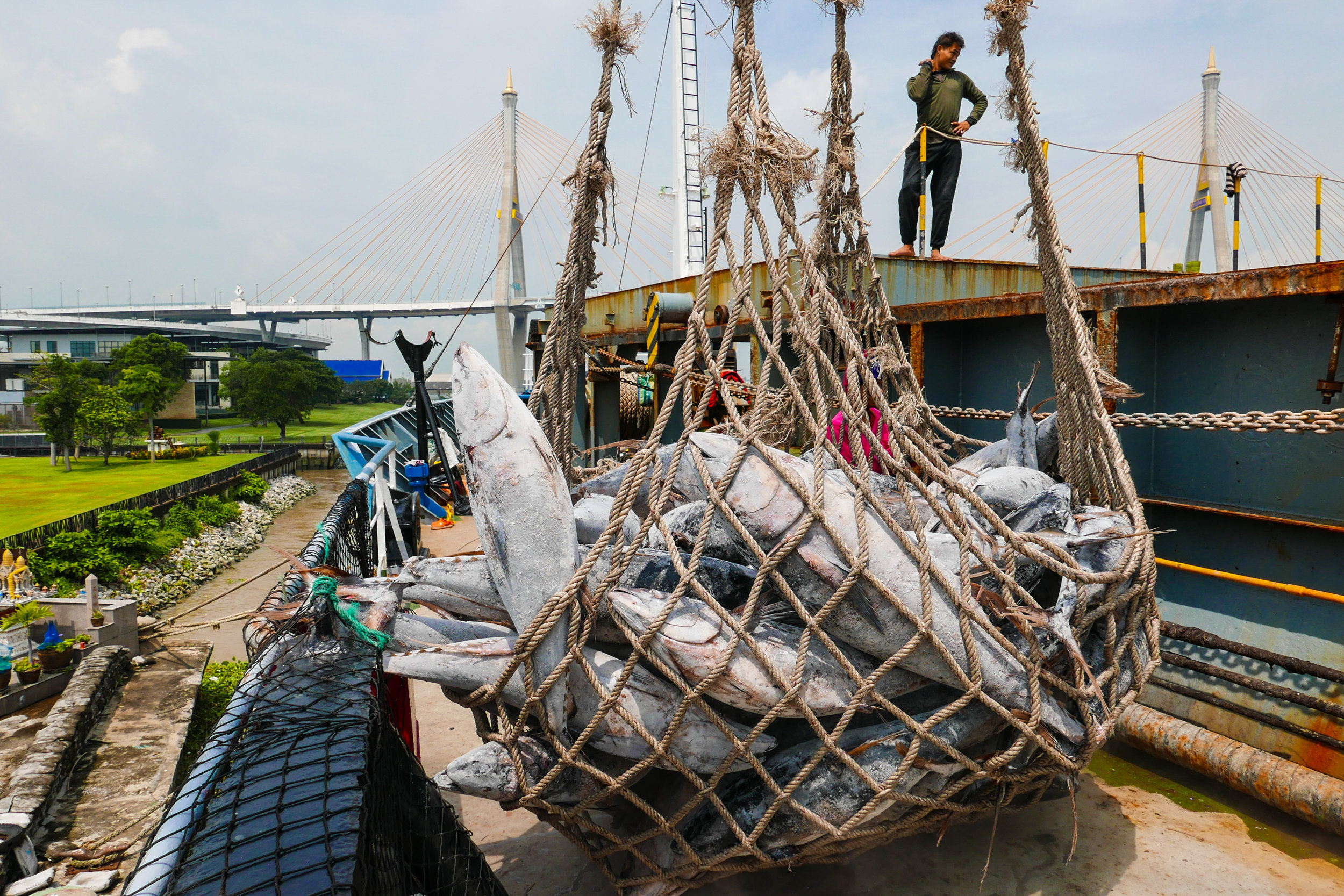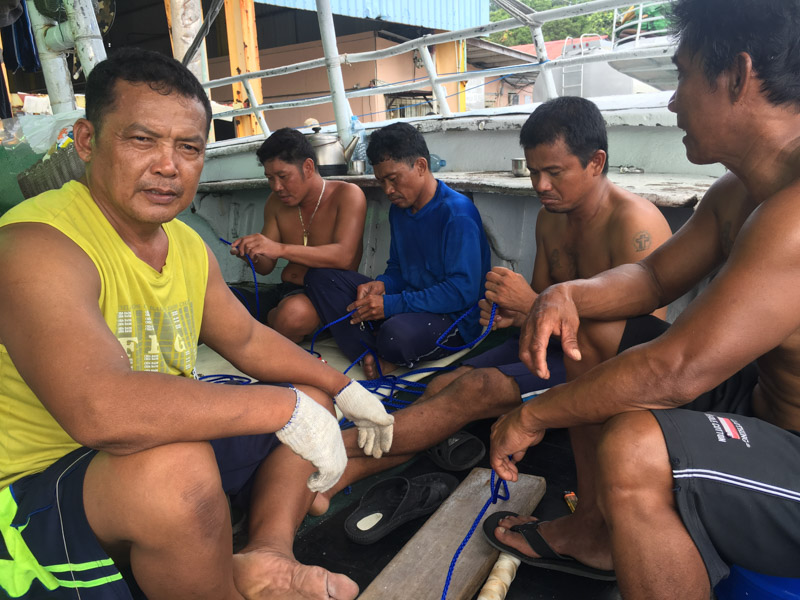I owe my life to fisheries. A hard job, full of good people and some real as**oles. Where politics are too involved and we forget that should be about people, food and fish. May my kids live in a world where fisheries day is in their present and not in their father's past.
An unconventional approach to estimating crew remuneration in fisheries /
As a former fisherman, and from a human perspective I feel (and wrote) that the real “race to bottom” in fishing, has been at crewing level. I don't believe that a young guy that starts fishing today could make enough money to pay for a place to live and his university studies like I was lucky to do. Hence I'm always interested in research on crew earnings and the different strategies to pay them, and this recent paper by D. Pinelloa, J. Gee (FAO) and K. Polymerosa in Marine Policy has been a good read. I hope the authors don't mind that I only quote the abstract and the conclusions, for the rest: read the original!
Took this picture while fishing in Coastal trawlers in the Gulf of Bengal in 2008. Marge shares for many days fishing... Really a hard life for those guys
Abtract
Fishing is a labour-intensive activity and consequently labour is one of its primary costs. Labour costs refer to remuneration, which is almost universally paid by means of some kind of crew-share system. At the same time, remuneration is the most challenging socio-economic information to collect, owing to a combination of complexity, sensitivity and the frequency of informal transactions.
Data on remuneration, when paid by means of crew-share systems, does not adequately capture the real value of income derived from fishing because it is collected as a singular monetary value. Furthermore, the remuneration of fishers’ labour, as recorded in vessel or company financial statements were generally found to be underestimated.
The main aim of this paper is to provide insight into the remuneration of fisheries labour so as to improve accuracy when estimating remuneration; the focus is on both the formula used for the calculation of remuneration and the data required, and an unconventional method that replicates the fishers’ methods is proposed.
This method allows for the sensitivity around discussions about remuneration, and the informal nature of these transactions, to be circumvented. The result is improved data quality. When remuneration is estimated in this way it naturally becomes an indicator for economic performance and livelihoods derived from fishing.
Fig. 1. Distribution of reported use of crew-share system in fisheries around the world with countries identified in the literature shown in dark grey. Back in Argentina we had a minal salary (thanks to the union) plus catch shares
Conclusions
In most fisheries worldwide, remuneration is made through a form of crew-share system rather than as a fixed wage. The crew-share system is prevalent in fisheries because it allows for risk and rent sharing, enhances productivity by providing incentives − particularly when the owner cannot monitor the fishers − and is also a traditional system that reflects the straightforward nature of effort inputs and catch outputs.
The prevalence of the crew-share system is also a reflection of the on-the-deck conditions of fisheries; fisheries activity and its accounting are relatively simple, even though activity levels and outputs are highly variable. When a crew-share system is in place, it is proposed that remuneration be calculated indirectly using the same formula applied by the fishers themselves. A comparison of ledger values versus formula values was made in four Italian fisheries and a clear underreporting of remuneration in the ledgers was recorded. Using the formula to calculate remuneration values also allows for the occurrence of the owner working on board the vessel to be accommodated in the data, and for the complexity, sensitivity and frequency of informal transactions to be considered. This results in the derivation of more accurate data on remuneration.
Enhanced quality of data on crew remuneration is important for the assessment of a fishery for two reasons: it provides a tangible measure of the financial contribution that fishing provides to the livelihoods of the fishers; and, when crew-share systems are in place, crew remuneration is a straightforward indicator of the overall economic performance of the activity − crew-share payments are not separate from the gross profit of the fishing activity, but rather they are correlated to it so that better economic performance results in better remuneration for the crew. In this context, crew remuneration should not be considered as a classic input, but rather as an output of the activity.
The methodology outlined above enables improved collection of remuneration data and contributes to better data quality for socio-economic assessments. The indirect calculation of remuneration allows for a shift in focus to the collection of the other elements and, in particular, revenue data and this provides the opportunity to also focus on improving the quality of that data.
Finally, good quality data on remuneration and associated indicators is critical for improved management, decision-making and policy-making.
The effect of hook spacing on longline catch rates /
As I said more than once, I like reading scientific papers (having time to do it is more the issue) this one got me thinking, and again I see science confirming stuff you talk on board with people that have been doing the job longer than you: “hooks compete with each other”. And while the job was done in Halibut, I wonder how it would work on toothfish, ling and/or long tail snapper as species closer to my experience.
The paper is on the dense side for the non initiated, so I hope the authors Cole C.Monnahan and Ian J.Stewart don't mind I only quote the abstract and the discussion.
Abstract
Catch per unit effort (CPUE) is a widely used index of population abundance for informing stock assessments for the purpose of estimating population status and setting fishing policies. However, for CPUE to be an unbiased index, influences that are not related to population abundance (e.g., spatial variation in effort and temporal changes in gear efficiency) must be accounted for in analyses known as CPUE standardization. In longline fisheries, one important factor that can affect CPUE is the spacing between hooks (‘spacing effect’), which influences effective effort and has largely been ignored in previous analyses. Here, we use the Pacific halibut (Hippoglossus stenolepis) long-line fishery as a case study to explore the spacing effect.
Both commercial and experimental (fishery-independent) data with hook spacing, and a survey-based CPUE series, are available for this fishery. It thus provides a unique opportunity to explore the effect of hook spacing and its effect on CPUE trends. We quantify this effect using non-parametric and parametric relationships inside a spatially-explicit (geospatial) CPUE standardization model for commercial data, and non-linear mixed-effects model for experimental data.
We found a clear non-linear spacing effect (i.e., hooks were less effective the closer they were), but accounting for space had a larger effect on CPUE trends than accounting for hook spacing. For this stock, it is likely the effect of hook spacing on CPUE was minimal due to little variation in average hook spacing over time. Regardless, historical and future trends in hook spacing can have important effects on longline CPUE standardization, highlighting the value of collecting this information. Accounting for hook spacing effects in other fisheries may improve estimates of trends in relative abundance and lead to better management.
Discussion
We found clear evidence for reduction in hook fishing power (or effectiveness) at smaller spacings, supporting the hypothesis that nearby hooks compete for Pacific halibut. This implies that for CPUE analyses, the relevant unit of effort is an effective hook.
We also found that the parametric form was a reasonable approximation for this relationship. Further, the parametric model fits to both the fishery-dependent and experimental data sets were fairly consistent, demonstrating this relationship can be estimated directly from commercial data, without the need for a controlled experiment.
Estimating effective hooks in the CPUE standardization has the added benefit that the uncertainty in the spacing effect is propagated into the trends of relative abundance. Lastly, despite a clear hook spacing effect, we found limited effects on standardized CPUE trends. This was likely because although there has been a temporal shift to different gear types, on average the hook spacing has changed slightly over the time period examined. Comparisons among other regulatory areas with systematic differences in gear usage may be much more important to the interpretation of Pacific halibut trends. Further, in other stocks managed with longline CPUE with significant temporal trends, ignoring hook spacing may mischaracterize abundance trends and lead to poor management decisions.
Our results support the hypothesis that hooks compete with each other, at least under the densities observed, and conditioned on the specific foraging behavior of Pacific halibut. However, the commercial data used here only contained information on retained legal halibut and set-level characteristics, and did not include key factors that certainly affect catch rates. For example, we were not able to account for the effects of environmental factors nor halibut size structure and density. Neither we were able to account for multispecies competition, which also has important influences on longline catch rates (Rodgveller et al., 2008). Thus, we caution against a biological interpretation of our results, and against applying our estimates to other species or situations, as foraging behavior may vary widely and lead to fundamentally different relationships (Fig. 1). For instance, initial captures of sablefish do not affect subsequent captures leading to a random distribution of occupied hooks, while Pacific halibut tend to cluster (Sigler, 2000). Future lab experiments on Pacific halibut or other species, while controlling for environmental and other key factors, would provide valuable corroboration and further insights in the relationship between individual foraging behavior, hook competition, and the resulting population-level hook spacing effects.
The assessment of Pacific halibut uses CPUE that excludes snap and autoline gear due to concerns over confounding between gear type, hook spacing, and changes in density (Stewart et al., 2016). Our analysis provides a method for including all gear types in future analyses and improving the information on which management is based. Although our analysis is specific to Pacific halibut, similar analyses for other stocks assessed, at least in part, with standardized longline CPUE could use a similar approach. For instance, hook spacing for sablefish is known to be important from experiments, but is not consistently reported for commercial catches and thus cannot be directly used in the CPUE standardization (Sigler and Lunsford, 2001). Likewise, CPUE analyses for bigeye tuna account for hooks between floats and hooks per set, but the length of sets are unreported and thus the effect of hook spacing is unknown (e.g., Hoyle and Okamoto, 2011). Our results demonstrate the potential value in collecting hook spacing for commercial longline catch data, and suggest incorporating this information in the future, especially for stocks with temporal or spatial trends hook spacing over time.
Efforts to estimate fish stock status from longline CPUE trends while ignoring spatial effort have been widely criticized (e.g., see debates in Hampton et al., 2005; Myers and Worm, 2003; Walters, 2003). As a consequence, incorporating spatial strata into standardizations is commonplace (Maunder and Punt, 2004). However, these improved methods still typically ignore spatial correlation among cells, and can be sensitive to cell resolution (Ichinokawa and Brodziak, 2010; Tian et al., 2010). One promising new method for accounting for space in standardizations is hierarchical spatiotemporal models (Thorson et al., 2015). Hierarchical models have become increasingly popular tools across a wide range of applications in fisheries science (Thorson and Minto, 2014), and their application for spatiotemporal models provides a natural approach for dealing with spatial complexities when estimating fish densities. In contrast to data collected using a random design (e.g., surveys), the preferential sampling of commercial data (i.e., high density areas are targeted; see Conn et al., 2017; Diggle et al., 2010) remains an open issue when using these methods.
We did not attempt to address this issue in our simplified model, here used as a proof of concept and to investigate hook spacing effects, but note we were encouraged that our estimates closely matched a survey CPUE trend (Fig. 6). However, before using these methods for management, we suggest future studies more closely investigate the effects of preferential sampling, in addition to other factors ignored here (e.g., zero catches and anisotropy), which may have an important influence on some stocks. We expect development of these models to continue being an active area of research, and will eventually be applied widely to analyze complex spatial fisheries data.
Trends in CPUE may not accurately reflect true trends in abundance due to a wide variety of confounding factors. Accounting for all such confounding factors is thus critical for successful fisheries management, but is a difficult proposition and will be a source of continued research.
For longline gear, in particular, the spacing between hooks clearly effects the effective effort leading to observed catches. This highlights the value in collecting hook spacing data on longline sets, particularly if there is the potential for an annual trend in hook spacing as gear configuration evolves in a fishery. Fortunately, the effective effort implied by hook spacing can be estimated within a spatially-explicit CPUE standardization model fit to commercial catch data. Including this effective hook relationship will likely lead to improved trends in relative abundance, and hence better management for other species caught by longline.
The 2017 FAO Voluntary Guidelines for CDS /
A recent and long overdue set of international guidelines on catch documentation schemes was adopted by the FAO Council in July 2017. My friend and colleague Gilles Hosch, did a thorough analysis of this document and its implications. It was published by Infofish magazine, and I quote below some of the key parts.
Following extensive stakeholder consultations (in which we participated) on how to prevent illegally harvested fish from slipping into global food supply chains, the Food and Agriculture Organisation (FAO) came up with new Guidelines which provide formalised guidance as to what Catch Documentation Schemes are, their aims, and how they should be designed and operated. The Guidelines could now provide a first step in the development of a more precise benchmarking tool for CDS.
Today, there are four CDS in existence. Three of these are multilateral CDS operated by Regional Fisheries Management Organisations (RFMOs), and one is a unilateral CDS operated by the European Union (EU) in its capacity as a market State.
Catch Documentation Schemes are a politically sensitive topic owing to their trade-related nature and their potential to impact and disrupt trade in fisheries commodities between trading partners and nations. With this in mind, the resulting Guidelines represent a cautious first step in describing the scope and nature of CDS, their objective, and laying out general principles and functional elements around which CDS ought to be built.
The objective of the Guidelines is
“to provide assistance to states, regional fisheries management organisations, regional economic integration organisations and other intergovernmental organisations when developing and implementing new CDS, or harmonising or reviewing existing CDS.”
This confirms that CDS can be developed through either multilateral or unilateral enterprise.
The term ‘CDS’ is defined as follows;
“Catch Documentation Scheme” means a system with the primary purpose of helping determine throughout the supply chain whether fish originate from catches taken consistent with applicable national, regional and international conservation and management measures, established in accordance with relevant international obligations, hereinafter referred to as “CDS”.
CDS are thus systems spanning the entire supply chain, allowing the industry for ascertaining the legal origin of the product throughout all stages of production.
Six basic principles and their application
The Guidelines enunciate a range of basic principles that should be followed when developing CDS, namely: a) be in conformity with the provisions of relevant international law; b) not create unnecessary barriers to trade; c) recognise equivalence; d) be risk-based; e) be reliable, simple, clear and transparent; and f) be electronic, if possible.
Harmonisation of CDS is a goal that may be pursued in the future. This particular point, explicitly mentioned in the objective of the Guidelines, finds resonance in the principle that equivalence (between schemes) should be recognised.
In addition to the notions of harmonisation and equivalence, the six principles introduce the important ideas of reliability – interpreted to mean that a CDS ought to be designed in a way that it is able to effectively achieve its objective – and transparency. Transparency is increasingly gaining traction in supply chain management, not only for monitoring and compliance purposes, but also serving the commercial goal of building consumer trust through the marketing of products claiming social and environmental responsibility; such claims may be more easily verified through ever more transparent and verifiable sourcing frameworks. Limiting the risk of reputational damage is part of private sector interests in pushing for more supply chain transparency, which will in turn facilitate the development and operation of future CDS.
The Guidelines lay out the de facto objective of a CDS in the following manner:
“Every effort should be made to ensure that CDS are only implemented where they can be an effective means to prevent products derived from IUU fishing from entering the supply chain.”
This mirrors the objective pursued through trade-related measures as provided in the 2008 FAO International Guidelines for the Management of Deep-Sea Fisheries in the High Seas: “adopt […] measures to prevent products from IUU DSFs from entering international trade.” It also reflects the provisions of the 2001 FAO International Plan of Action to Combat, Deter, and Eliminate IUU Fishing on the same topic: “[…] to prevent fish caught by vessels identified […] to have been engaged in IUU fishing being traded or imported into their territories.”
The notion that a CDS must be able to effectively prevent IUU-derived product from entering the supply chain is key, and must be emphasised. In other words; if mechanisms inherent in the CDS do not allow for the detection of IUU fishing operations, and IUU-derived products are able to gain certification and to migrate as legally certified products along supply chains towards their end-markets because of this, then the CDS cannot contribute significantly to eliminating IUU fishing. The capacity of the CDS to detect (and eliminate) fraud at the beginning of the supply chain is key, and ought to precede the decision of whether a CDS is an appropriate tool to implement or not.
With regards to the CDS objective, the Guidelines also provide that CDS should only be implemented “from within the context of an effective fisheries management regime”. This consideration is critical, since the relative lack of regulatory substance regarding the exploitation of given stocks implies a relative lack of substrate for a CDS to act upon.
Another element of critical importance regarding the principles and their application is the development and use of secure electronic systems for the operation of CDS in order to forego the risk of falsification. The Guidelines provide key attributes and functions that electronic systems should be endowed with, including the following:
- Serve as the mechanism for issuance and validation of catch certificates
- Function as the repository of catch certificate and supply chain data;
- Allow verification of information;
- Ensure that accurate and verifiable information is available along the supply chain;
- Be based on international standards for information exchange and data management;
- Minimise the burden on users;
- Provide functions for uploading scanned documents;
- Provide functions for running data queries;
- Define roles and responsibilities for data input and validation;
- Provide secure access via logins and passwords; and
- Define system levels that individual users or user groups have access to.
Certificates should hence be issued and validated through an electronic system, which serves both CDS functions of data generator/validator and data warehouse (points 1 and 2 above) allowing data to be linked (point 5) and to remain available and accessible along the entire supply chain (point 4).
This embodies what is more commonly referred to as a central registry (or central data repository). The central registry is the centrepiece that provides a basis for effective supply-chain traceability, and allows a CDS to effectively meet its objective. It is this instrument that enables meaningful verification of information (point 3), either in manual or automated fashion, along the entire supply chain from harvesting of fish to the final point of importation of fisheries products, and provides the ability to detect (and to deny) laundering attempts. In the absence of a central registry, verification of information becomes difficult, and in longer supply chains, operators and regulators may become unable to establish the validity of the paperwork accompanying consignments delivered to premises, or – in the case of authorities – imported into territories. Both CCAMLR and ICCAT operate such electronic central registries today.
Cooperation, notification, functions and standards
Other attributes and functions provided for in the Guidelines – generally relating more to CDS development and implementation modalities –include the following;
- States should seek wide multilateral engagements in the development and implementation of CDS;
- Cost-effectiveness considerations should guide […] the development and implementation of CDS;
- Multilateral or regional CDS are preferred;
- The objective of a CDS should be clearly defined;
- The CDS should be designed to meet its objective;
- Applicable Harmonised System (HS) classifications should be listed;
- In the validation process, different roles of relevant states to authorise, monitor and control fishing operations and verify catch, landing, and trade should be fully recognised;
- Validation of catch documentation information should be done by a competent authority;
- All relevant states could take part in the verification of information in the catch documentation
It emerges that multilateral approaches are preferred in developing CDS (points 1 and 3).
Points 4 and 5 – notwithstanding their obviousness and logic – are important also. With a single exception, none of the existing CDS clearly define the objective of the scheme, and are hence prone to meander, to add functions not in support of the (putative) objective, and therefore become more burdensome, more ineffective and less cost-effective over time. CDS functions can only be developed effectively when an agreed and clear objective is being pursued.
The definition of the HS categories (point 6) to which the scheme applies is also important, and sometimes embodies an alienating factor for fisheries practitioners. However, since the CDS is a trade-based tool, and is largely implemented through the action of border control agents and the customs agencies they respond to, the translation of fish species and fish products into customs codes is of essence to ensure the smooth implementation of envisaged controls at the level of international trade. This, in turn, assists in identifying the need for developing more detailed HS codes in specific fisheries and supply chains over time.
Another key point relates to the state-types responsible for verifications and validations of certificates (points 7 and 9). Under all currently existing CDS, and with few exceptions, the flag state has the exclusive competence for the verification and validation of catch certificates. However, under international law, both the coastal state and the flag state have shared responsibility to oversee fishing operations in the EEZ.
Expanding verification and validation competence in future systems serves the purpose of limiting the primacy of flag state validation in the CDS landscape. Such primacy is inconsistent in the context of a trade-based tool, bearing in mind the historically pervasive and documented failures of flag states to discharge their duties under international law.
Trade-based and port-state measures – the latter enshrined in the 2009 Agreement on Port State Measures to Combat, Deter, and Eliminate IUU Fishing (PSMA) – ought to be understood as efforts to overcome the shortcomings of flag state jurisdiction and enforcement, and to spread duties and responsibilities for combatting IUU fishing more evenly among concerned state parties. One consideration, inter alia, regarding expanded verification and validation responsibilities under a CDS would be for coastal states to be endowed with a statutory catch certificate validation function for catches made in their EEZ – in cases where the flag and the coastal state are not the same.
Finally, an act of validation of catch documentation (i.e. a certificate) by a designated competent authority is a hallmark of catch documentation schemes (point 8). This has implications as to whether the impending US Seafood Import Monitoring Program (SIMP) – due to enter into force in January 2018 – will qualify as a CDS system, or will eventually be relegated into a category of trade-based measures of its own standing. The SIMP does not foresee the development and implementation of a certification system in the classic CDS sense, and validations of scheme-specific paperwork will not normally be provided by competent authorities along the supply chain upstream of final exportation to the US market. The onus to collect supply-chain information establishing the supposed legality of imported products would largely rest on importers under the SIMP.
Outlook
Seventeen years after the coming into existence of the first CDS globally at CCAMLR, the 2017 FAO CDS Guidelines enter the spotlight and provide much needed and formalised guidance as to what a CDS is, what it is aiming to achieve, and how these schemes should be designed and operated. This should help in dispelling general misconceptions about what the functions and objectives of these schemes are, and should also be instrumental in better focusing current efforts at RFMO level to develop such schemes.
The Guidelines could also embody a first step in the direction of developing a more encompassing and precise CDS benchmarking tool, which would allow assessing and revising existing schemes against an agreed standard and on the basis of which new schemes could be developed faster, more effectively, and with much more confidence
Thailand is working hard to revert their situation /
I wrote in the past on Thailands' PSMA signing and the impact of the EU's DG MARE yellow card and DG SANTE bad report on the Thailand's fisheries sector. Add to that the forced labor issues, Greenpeace campaigns, and the lot... the picture wasn't a pritty one.
And as I said last year: I'm not going to even try to dissect the whole tangled mess. But yes... Thailand has not been particularly clean, but then, they weren’t been pushed to be clean (quite conveniently) by the international community, nor their clients. They have a very efficient and effective production system, but their fisheries controls have been kind of the opposite.
I think a red card was actually never on the agenda, since tuna imports from Thailand to the EU would have not been affected, since the IUU Regulation is a flag state measure. This means that for the purposes of imported foreign-caught raw materials, Thailand is considered a processing state rather than flag state, and the regulation is not explicit about processing state responsibilities in terms of addressing IUU fishing (they only require the completion of an annex to EU Catch Certificate regarding processing - "the processing statement").
Having worked here before, I was quite happy to be contracted by the Thai Department of Fisheries and Ocean Mind (that has been working with DoF on PSM support by doing intelligence analysis via IAS on the Advance Request Entry to Port -AREP that Thailand requires from all carriers coming to unload).
Ocean Mind has been working with DoF on PSM support by doing intelligence analysis via IAS on the Advance Request Entry to Port -AREP that Thailand requires from all carriers coming to unload. My job was to evaluate Thailand's systems and improvements, they contacted me by a recommendation of the Papua New Guinean government, who were quite happy with the work I did with them during their yellow card period.
After having helped 6 countries to get off their "Yellows" and having been a dodgy fisherman (in a past I'm not too proud of), I have become some sort of a IUU control systems and the EU Catch Certification systems designer and beta-tester for many countries. And this was the role I was asked to perform over two "full on" weeks around ports, factories, offices, border crossings and container ports in across Thailand, trying to "hack" the system and then providing feedback on the issues found.
Finding issues and inconsistencies in peoples' work is not a role I enjoy, yet that is what IUU operators do. So I always start these jobs explaining the situation and asking them to see me as "mother in law" who's nature is to find the 1 thing wrong among the 99 that are right.
I'm not going to go into the details, but I was pleasantly surprised with the advances and scope of their systems. Their commitment to a better management of its fisheries resources, control over its fisheries, as well as the legality of its fishery imports is to be recognised. It never felt "fake" to me, or that they were trying to put on a "performance" I was given full access to anything I needed.
The country has upgraded in a very short time its control systems with the aim to be at international best practices, and its fishery administration has gone over a generational shift, I worked with many young and committed people in positions of power, which really was quite refreshing.
While there are issues that still need more attention, most of the recommendations I provided refer to the strengthening and refinement of existing tools and initiatives, and not the creation of completely new ones, which would have been the case only a few years ago, when I last work there. It has been a remarkable turnaround.
In fisherman talk: "3 years ago they had no boat, today I was discussing gear improvements and the boat finishing details, while we all were standing on it doing sea trials".
I’m totally aware (because advising on these type changes is my job) of the level of effort and commitment required by the fisheries sector (government and industry) to get to this stage. So it did not surprise me to learn that no one in DoF had holidays in the last 18 months and working till 9 pm on a Saturday night, did not raise an eyebrow (other than my ones!)... I have never seen that in any Fisheries administration in my life.
I can only congratulate all involved and keep working the weak angles identified as to sustain the efforts into the foreseeable future, no one wants to come back to what it was 2-3 years ago when I last evaluated your (lack off) systems.
Obviously (albeit unfortunately) the “name and shame” strategy of the EU, has been an effective catalyser to get things into action. Yet in any case, the fishing world wins with a Thailand living up to its responsible fishing nation capacities. The battle they are winning there, has massive repercussions to the tuna industry, both in terms of Illegal but also unreported fishing.
would not have trusted the legality and eligibility of this load a couple of years ago... now I do
Safety at Sea and the Cape Town Agreement / Torremolinos Protocol /
I wrote before about the safety of fishers, fishing is the most dangerous occupations in the world, with an annual fatality rate of 80 lives per 100,000 fishermen.
There is a long-standing cooperation between the International Maritime Organization (IMO), the International Labour Organization (ILO) and FAO, in particular in improving safety at sea in the fisheries sector.
This long-standing collaboration has resulted in the development of a number of binding and non-binding instruments that address the safety of fishing vessels and their crews. Thanks to this cooperation, there are now international instruments in place that apply to fishing vessels of all sizes and the personnel working on board those vessels.
One of the binding instruments is the Cape Town Agreement of 2012 on the Implementation of the Provisions of the Torremolinos Protocol of 1993 relating to the Torremolinos International Convention for the Safety of Fishing Vessels, 1977, which was adopted on 11 October 2012 in Cape Town, South Africa.
The Agreement applies to fishing vessels of 24 m in length and over, operating on the high seas, and will enter into force when it has been ratified by at least 22 States, with an aggregated fleet of at least 3 600 fishing vessels of 24 m in length and over.
The safety of fishing vessels concerns not only the technical elements of the design, construction and equipment of the vessels but also a number of social and economic factors.
Overcapacity and overfishing of coastal resources has led to high competition to catch limited resources. Pressures on owners and skippers to ensure economic survival can result in cost cutting on vessel maintenance, safety equipment and labour with negative consequences on safety.
Safety in fishing operations cannot, therefore, be separated from fisheries management and this is recognized in the provisions of the FAO Code of Conduct for Responsible Fisheries which addresses safety and health in the fisheries sector.
The Committee on Fisheries (COFI), which is one of FAO’s governing bodies, has repeatedly welcomed the ongoing cooperation between IMO, ILO and FAO. During a recent meeting of the Committee, many Members recognized that there is a link between safety at sea, forced labour and illegal, unreported and unregulated (IUU) fishing and they referred, in this regard, to the 2007 ILO Work in Fishing Convention and the Cape Town Agreement.
These legally binding instruments will not only improve safety at sea in the fisheries sector and working and living conditions on board fishing vessels, but will also be useful tools in fighting IUU fishing, together with the FAO Port State Measures Agreement.
It is the responsibility of the flag State of a fishing vessel to ensure that the vessel meets internationally agreed standards, such as the Cape Town Agreement, the STCW-F Convention, the ILO Work in Fishing Convention and the FAO Port State Measures Agreement.
Port State control/measures is a supplement to flag State control and a cost-effective tool to fight substandard fishing. When a fishing vessel, which falls under the scope of one of the above-mentioned legally-binding instruments, is in a port of a Party to that instrument, other than its flag State, it will be subject to inspections, carried out by an inspector, duly authorized by the port State authorities, on matters related to safety, working and living conditions on board and matters related to fishing equipment and fishing operations, in order to confirm whether the vessel complies with the requirements of the relevant instrument.
If the condition of the vessel or its operation does not correspond to the requirements of the instrument, the inspector can require the deficiencies to be rectified before the vessel leaves the port and, in more serious cases, detain the vessel.
It is, therefore, expected that port State inspections will considerably reduce the chances for unscrupulous operators to get away with bad behaviour, such as undertaking IUU fishing using unsafe vessels with unacceptable labour conditions.
IMO, FAO and ILO have emphasized that in order to achieve good results, in improving safety at sea and labour conditions in the fisheries sector as well as in the fight against IUU fishing, it is essential to have close cooperation and coordination at national and regional level, in particular between the maritime, fisheries and labour administrations.
Source here
EU Yellow Card to Vietnam /
In January this year, I wrote in a blog entry (and on an SPC article): "If a country does not control its fleets, then its products should be subjected to higher tariffs until this issue is solved. Add to this a European Union ‘yellow card’ – which uses the potential of trade controls to incentivize countries to effectively combat illegal fishing – and perhaps Vietnam will take more action to address the various contributing factors originating within its jurisdiction". So obviously I was quite pleased to read that the EU's DG MARE notified to Vietnam that it was considering it a non-cooperating country in terms of IUU fishing.
I wrote many times before about the "yellow cards", the EU IUU Regulation (EC No 1005/2008), the Catch Certification Scheme (CCS) and yellow and red cards the EU has been delivering around.
It is important to understand that the EU IUU Reg has as its implementation tool, the Catch Certification Scheme (CCS)* , while the “yellow and red card” is a football analogy to the process that the EU DG MARE enters when it invokes Chapter IV of the regulation with “non-cooperating third countries”. The “cards” analogy has been the most "visible" element of the regulation. Its effectiveness has worked in some of the countries that have been “given a card”, since the “name and shame” and the possibility of having the products caught by its vessels barred from the EU market has been a effective way to get them into action, no doubts there.
In the case of Vietnam, the lack of control on their fleet was summed to poor landing controls and surely issues around raw materials eligibility and traceability, particularly now that Vietnam is becoming a more prominent "processing state" in the fish world as well have been cited as the reasons for the card.
Therefore Vietnam will have to ensure that opportunities for “tariff-hopping” are minimised, this has to happen through the implementation of effective traceability, harmonised authorisations and record keeping systems between agencies tasked with monitoring imports, processing, certification of origin - CoO, issuing of health certificates, issuing of Catch and/or Re-export Certificates, and monitoring of exports.
My recent work in Thailand (read about it here) that has impressively changed its ways in the last 2 years proves that the yellow cards can catalyze change. Thailand has done an incredible amount of work and a generational shift in the control of its own fishery, the arrival of carriers with foreign-caught fish and the control of the value chain.
Yet, as I said I hope that this yellow card catalyzes change in Vietnam for the better.
And since they (the EU) are on roll... they may aim to Latin America, since they as a whole must be the main exporter of fisheries products to the EU by volume and value. The evaluations we did in 2011 showed all sorts of issues, and there are no objective reasons to assume that they fisheries administrations and enforcement bodies are insulated of the otherwise well-known corruption culture that permeates many governments there... but not even one yellow card have been raised. (Hopefully the fact the European companies have substantial investments there, has no bearing on that lack of scrutiny)
And then towards the end of 2018 they tackle China, by far the nation that has been involved in more IUU fishing events worldwide, had vessels sunk, arrested, detained, they are notorious flag hoppers and the lot... yet not one visit has been raised.
*The EU Catch Certification Scheme (CCS) has been largely ineffective due to some due to profound flaws in its design and implementation. A group of us have been very vocal about this for years, and I was happy to see that that message has finally been taken by EU based NGOs. My criticism was always constructive and not against the legislation or the CCS, but aimed at maximising its benefits... yet almost 8 years after its implementation, the key flaws still have not been fixed.
Barriers to Large-scale Interoperability of Traceability Technology in Seafood /
If you read, you learn, and I like doing both. My mate Ken Katafono recommended this paper, which is quite interesting. Is one for the insiders of traceability for compliance, not easy digested, but good stuff. I summarize some areas below, but as always, I recommend going to the original: Hardt, M. J., Flett, K. and Howell, C. J. (2017), Current Barriers to Large-scale Interoperability of Traceability Technology in the Seafood Sector.
Abstract
Interoperability is a critical component of full-chain digital traceability, but is almost nonexistent in the seafood industry. Using both quantitative and qualitative methodology, this study explores the barriers impeding progress toward large-scale interoperability among digital traceability systems in the seafood sector from the perspectives of seafood companies, technology vendors, and supply chains as a whole. We highlight lessons from recent research and field work focused on implementing traceability across full supply chains and make some recommendations for next steps in terms of overcoming challenges and scaling current efforts.
Introduction
Full-chain digital traceability is the use of electronic records and technology both to track the forward movement of a product through various stages of a supply chain and to trace backward the history of that product, including locations, transformations and applications (Bhatt and others 2016).
The core question among those trying to solve the global overfishing crisis has thus shifted from what needs to be done, to how can it be done?
Interoperability—the ability of different information technology systems or software programs to communicate seamlessly for the purpose of exchanging, interpreting and using data (Bhatt and others 2016)—is a critical component of full-chain digital traceability, but is almost nonexistent in the seafood industry.
This study explores the barriers impeding progress towards large-scale interoperability among digital traceability systems in the seafood sector. We define a barrier as an internal or external factor preventing a particular initiative from gaining scalable traction. Barriers can relate to market conditions, human beliefs and behaviors, cultural norms, or wider issues related to the system in which the barrier exists. Barriers are presumed to be movable, given the right design strategy.
Current state of seafood traceability
For the seafood industry some of those barriers include:
- Lack of awareness of and education on the need for traceability technology, especially at the full-chain level;
- Knowledge gaps of what full-chain traceability is and what full-chain digital traceability does;
- Poorly demonstrated incentives for creating buy-in to the value full-chain digital traceability can offer;
- Resource deficiencies, including funding and capacity issues;
- Technical issues with information technology (IT) systems and data management;
- Logistical hurdles in the operation of traceability systems; and
- Scaling issues in promoting and achieving broader adoption.
These barriers will manifest more or less strongly depending on the structure of the supply chain, supply chain relationship dynamics, and where a company sits within the supply chain (Sterling and others 2015).
In recent decades the seafood industry has experienced an upward trend in seafood supply chain companies adopting and implementing internal traceability technologies—those that enable a company to track and preserve information about individual batches or units as those batches or units are processed within a company's facility.
Internal traceability solves most of the food safety and recall needs of the food industry. That function alone, however, is not sufficient for product-level information to be captured, stored and passed along to other trading partners in a manner that provides access to and preserves the integrity of that data so as to maximize traceability benefits across the supply chain, such as by reducing risk and preventing corruption.
External traceability—the ability to track key data elements (KDEs) and other information about seafood products as they move between trading partners and through the supply chain—must be in place to achieve that higher level of information capture. External traceability hinges on trading partners making commitments to share relevant information with other trading partners, either in one-up, one-down fashion or via a cloud-based system.
External traceability alone, however, does not provide the supply chain transparency, data tracking, or accountability that a company would need in order to ensure that it was not trading in IUU, mislabeled, or fraudulent products—products that, unfortunately, are still prevalent in seafood supply chains.
That level of full-chain digital traceability requires the performance of at least 5 core traceability technology functions including: vessel-dock capture, product-data pairing, internal traceability, supply chain visibility, and data
In 2015, Future of Fish (FoF) convened 15 of the leading traceability technology vendors working in the seafood industry and found that while all of these functions were performed by at least 1 of the technology vendors, no single vendor performed all 5 functions.
Thus, 2 types of collaborations are necessary in order for full-chain digital traceability to succeed. First, multiple supply chain partners must agree to share some level of data. Second, technology vendors must collaborate around supplying services and products within a specific supply chain so that their systems can effectively communicate and interpret this data (for example, interoperability).
Understanding interoperability
The term interoperability, like traceability, means different things to different people and, thus, deserves explanation. Interoperability is the ability of different information technology systems or software programs to communicate seamlessly for the purpose of exchanging and using data (Bhatt and others 2016). For systems to be truly interoperable, they must have both the capacity to share data using a common data format (syntactic interoperability), and the ability to interpret and understand that shared data with common meaning (semantic interoperability).
There are currently 3 basic methods for electronically sharing and communicating data.
The first, Electronic Data Interchange (EDI), shown in Figure 1, is the oldest and most common form and is used often in eCommerce. EDI relies on a text-based standard for everyday business documents and requires a “middleman” to translate transactions. This middleman, known as a Value Added Network (VAN), is often very expensive, with initial start-up costs ranging from several tens of thousands to hundreds of thousands of dollars, and transaction charges in the thousands per month (Simmons 2007). Although some modern forms of EDI do allow for data sharing directly between Enterprise Resource Planning (ERP) systems, the method remains restricted to node-to-node and does not support full-chain traceability, nor data sharing among multiple systems.
Figure 1. Schematic of a typical EDI data-sharing system.
The second method of data sharing—and one that is gaining traction—is the use of an Application Program Interface (API). Shown in Figure 2, APIs are custom software interfaces that allow 2 distinct systems to communicate electronically. For example, an API for Microsoft Windows helps programmers know how to configure their software to communicate with a Windows platform. Several seafood traceability technology providers have developed custom APIs that allow 1 or more systems to seamlessly share data with those providers; however, these remain limited to the specific systems for which they were built.
Figure 2. Schematic representing components of API-based data sharing
In this diagram there are two APIs. The semantic and syntactic definitions are setup to be the same so that communication happens, but this requires programming on both sides.
While APIs may embed some global standards, they are not based on any end-to-end semantic or syntactic interoperability standard and, thus, do not allow data sharing and communication across multiple supply chain nodes. The exception to this is when an API is provided as a service across a supply chain; several technology vendors have developed this functionality, allowing multiple nodes in a supply chain to share data. However, the limitation here is that all electronic traceability systems in that supply chain must conform to the specific API of that single traceability technology vendor. This is not a universal API that would allow sharing across multiple supply chains (unless every seafood supply chain globally was using the exact same traceability service provider).
The third method of data sharing is a cloud-based ERP system, which tends to be employed mostly by companies with limited technology capacity. Cloud-based ERP systems, shown in Figure 3, require data entry via a browser, which is then shared into a cloud-based database. The information in the database can then be passed, via API or a VAN for EDI, to an ERP system 1 node up or down the supply chain, or to a retailer at the end of the chain. Most often, the host of the cloud-based data system is not a member of the supply chain, but a third-party technology provider. While the cloud-based solution can provide an on-ramp for electronic data sharing to a company without a more sophisticated system, the additional step of manually inputting data into the browser can be very time consuming, and the system is still limited in terms of where data can be shared, requiring a custom API or a more expensive VAN.
Figure 3. Cloud-based ERP data sharing system.
The seller enters data into their browser, which then connects to the cloud-based ERP.
In contrast to the 3 methods described above, true interoperability, depicted in Figure 4, allows for unlimited and unfettered machine-to-machine data sharing and communication. Two systems can share and effectively interpret data without a translation service. Such true interoperability relies on established standards. Although such standards exist, such as GS1, adoption within the seafood industry sector has been almost nonexistent.
Figure 4. True interoperability, where machine-to-machine communication can happen without the need of a translator service or any one service provider, allowing cross-supply chain and industry data sharing and communication.
Objectives
The objectives of this research were to use qualitative methods to:
- Identify where interoperability exists within the seafood industry and where there are gaps;
- Identify the challenges impeding interoperability, including nontechnical ones, at both the seafood company and technology vendor levels; and,
- Highlight existing initiatives working to overcome these challenges.
Discussion
Our discussion focuses on the barriers to interoperability from the perspectives of seafood companies, technology vendors, and supply chains as a whole. Additional factors, such as value chain type, have also been shown to influence the kinds of barriers preventing interoperability (Bhatt and others 2016). These factors will be important to consider in terms of how seafood companies and technology vendors may need to prioritize strategies for addressing the challenges noted here. To assist with this, we also describe several underlying tensions or counteracting forces that often create inertia or perpetuate the status quo (that is, no interoperability). And, we offer lessons from recent research and field work focused on implementing traceability across full supply chains, and make some recommendations for next steps in terms of overcoming barriers and scaling current efforts.
Barriers to seafood companies pursuing interoperability
Before interoperability can be implemented, it must be recognized. The barriers described below reflect factors that seem to be preventing companies from becoming aware of interoperability and recognizing its value. These barriers emerged as themes based on a process of pattern-finding to analyze the qualitative data from the online questionnaires.
An industry culture of competition, not collaboration
Interoperability requires a level of inter-business collaboration that is unprecedented in the seafood industry. Seafood businesses work on small margins and with a self-protective skepticism around the trustworthiness of competitors and trading partners. They guard their supply chains and sourcing practices closely, fearing that leaked information could damage business and reduce profits. The idea of interoperability—where specific product-level data are shared machine-to-machine all along the supply chain—is not only perceived as too risky, but is also antithetical to current industry culture.
Discounted value of interoperability
Traceability itself is relatively new to the industry, and the concept of interoperability is not even on the radar for many seafood companies. Thus, while the value of interoperability may be clear to those who understand its potential, most seafood executives are either unaware, or downplay the benefits because they are too hypothetical, long-term, or uncertain. The gains companies tend to realize through their traceability systems have to do with internal efficiencies, maintaining contracts with high-value customers, or marketing. Some find it difficult to imagine the complete benefits, especially supply-chain level benefits that interoperability makes possible through robust, end-to-end traceability. Others see the benefits as purely social (such as improvements in human rights across the industry as a whole) and, thus, not within their individual business interests. Making data capture and sustainability information relevant to seafood companies is a challenge, especially when consumer demand for detailed data is perceived as relatively low.
Barriers to seafood companies implementing interoperability
Once seafood companies are aware of the value of interoperability, they face new challenges related to implementation. The barriers described below emerged as themes based on a process of pattern finding to analyze the qualitative data from the online questionnaires.
Scarce resources are already fully tapped
Interoperability requires both capital and human resources. Even when a seafood company's leadership sees the potential value of integrating with other systems, the cost of implementation can be prohibitively high. This is especially true for custom ERP systems and legacy systems. Interoperability implementation can require significant attention from IT staff (where such staff exist), many of whom already have more work than they can handle. Seafood companies without IT staff have no choice but to hire an IT consultant to do the work, or to pay the premium that most ERP systems charge for custom integrations. Adding to the financial burden, interoperability implementation and the related back-end code updates can take the entire system offline for weeks. Most companies cannot afford that level of disruption to their operations.
Barriers to technology vendors pursuing interoperability
In addition to the factors impeding adoption of interoperability among seafood companies, technology vendors face their own barriers when it comes to integrating with other platforms. The following barriers emerged as themes based on a process of pattern finding to analyze the qualitative data from the interviews with technology vendors.
Perceived risks outweigh uncertain benefits
While the risks of interoperability perceived by seafood companies concern privacy and security, traceability technology vendors see interoperability as potentially jeopardizing their business futures. They cannot afford the costs to both their bottom lines and their reputations of attempting to interoperate with another vendor—especially a young, unproven start-up, as many traceability vendors still are—without guarantee of success. Some traceability companies have made false claims about the services that they provide and, thus, vendors interested in integrating with other vendors have to do their own vetting process before moving forward with partnerships. Interoperability among vendors occurs most often when integration is requested from their clients (that is, seafood companies), which is relatively rare for the reasons described earlier.
Barriers to technology vendors interoperating
System incompatibility
The manifold electronic data systems used in the seafood industry presents a significant challenge to interoperability. In general, integrating with an ERP system is more straightforward than integrating with a cloud-based traceability system. However, older systems, custom-built systems, and platforms built on obsolete operating systems (Windows 95, for example) can pose incompatibilities that are not rectifiable and, as a result, interoperability partnerships are abandoned. In many cases, interoperability requires system-to-system customization, which when trying to link an entire supply chain may mean designing custom integrations with several very different systems, each built on their own platforms.
Barriers to seafood supply chains interoperating
In the case of both seafood companies and technology vendors, interoperability will only succeed to the extent that all players in the supply chain are willing and active participants. The barriers described below reflect factors that impede entire supply chains from interoperating. These barriers emerged as themes based on a process of pattern-finding to analyze the qualitative data from both the online questionnaires and the interviews with traceability vendors.
A chain is only as strong as its weakest link
Interoperability is not simply a decision made between 2 trading partners; all supply chain actors must comply and demonstrate at least a minimum level of commitment. Thus, supply chains that include businesses that lack traceability cannot interoperate; supply chains that include businesses that cannot (for cost or technical reasons) or refuse to integrate their systems even though all other trading partners are on board cannot interoperate. Meanwhile, supply chains that include businesses using traceability technologies that are inferior with respect to data handling or data security, may not realize the full benefits of interoperability, or may decide that interoperating is too risky.
Lack of consistent data standards
Interoperability requires sets of standardized data formats and data fields that all systems can follow. Although certain standards (for example, GS1 and EDI) exist, most seafood companies are not members of such schemes, namely due to cost and lack of demand from their customers for such standards. Given that most companies have their own internal product SKUs, even if systems are made to speak the same language (syntactic interoperability), they must also be able to exchange data in a meaningful way (semantic interoperability). Thus, if a seafood company or technology system is GS1 compliant, for example, but the data received from the supplier are not formatted correctly, the information cannot be passed along. The absence of universal product codes for the hundreds of thousands of different combinations of species, product types, product forms, product weights, and so forth passing through seafood company databases may be one of the most formidable barriers to interoperability. Further complicating the situation, some major buyers have their own “flavors” of EDI, forcing customization even within a “standard.”
Opportunities for moving forward
This research highlights the range of technological, financial, logistical, and cultural barriers to interoperability currently facing companies and technology vendors working within the seafood supply chain. As with any system-level problem, tackling these barriers in order to scale interoperability requires a comprehensive strategy—one that is beyond the capacity of any single company, government, or organization to achieve. However, individual efforts working in concert can provide the multi-pronged approach necessary to initiate forward progress.
The following initiatives are examples of ongoing work to address particular barriers to interoperability in the seafood supply chain. Some of these efforts are more closely coordinated than others. Based on our findings, continued dialogue and knowledge sharing may be fruitful as these projects progress in order to accelerate interoperability and ultimately, adoption of digital traceability systems across seafood supply chains.
The seafood traceability technology architecture and rollout strategy
This project, led by the Institute of Food Technologists’ Global Food Traceability Center (GFTC) is intended to address the growing need for a global, secure, interoperable seafood traceability system by designing a common technology architecture. Details of this work are presented in articles by Bhatt and Gooch (2017), Bhatt and others (2017), and Gooch and others (2017) on pages 22 and 45 of this supplement.
Barrier addressed: lack of consistent data standards
Financing full-chain traceability
FoF is leading efforts to develop novel ways of financing the implementation and long-term maintenance of full-chain traceability. Through this effort we hope to help alleviate some of the burden that interoperability brings, especially to seafood producers and processors. By reinventing the traditional transaction model, this initiative seeks to unlock the full value that accurate, shared data provides to seafood companies, governments, and NGOs and move digital traceability from something currently funded by foundations to an investment made by industry.
Barriers addressed: an industry culture of competition, not collaboration; scarce resources are already fully tapped
Catch documentation and traceability architecture
With the GFTC, FoF is currently under contract with the U.S. Agency for International Development's (USAID) Ocean's and Fisheries Partnership Program to design a technology architecture for interoperable communications between traceability vendors, supply chain members, governments, and others to effectively communicate information that meets the KDE and privacy needs of fishery stakeholders (USAID 2017). The result of this work will be a published and vetted architecture that allows interoperable web services to effectively and efficiently communicate among data technologies.
Barrier addressed: lack of consistent data standards, system incompatibility
Conclusions
If you build it, they may come; but then again, they might not.
When asked, the majority of those involved in the seafood industry—from seafood companies to NGOs to government officials—tend to assume that the biggest hurdle to interoperability is technical in nature. That is, technology vendors still have not done the work to make their systems compatible. Yet, research shows that this is not the case. The technical ability to join 2 data systems has long been available. It is the scaling of that process that remains stalled.
Generally speaking, traceability technology providers see value in interoperating, both in terms of services to their clients, for growing their customer bases, and for competitive advantage. Yet, demand for interoperability is currently lagging.
Today, technology companies have 2 choices: either pursue interoperability despite lack of customer demand in hopes that existing and future customers will realize the benefits and eventually come on board; or wait for demand to hit critical mass and then spring to action. Either decision requires a leap of faith: the former involves significant upfront investment with no guarantee of returns while the latter risks missing out on the potential advantage of being among the interoperability pioneers. Accelerating buy-in to the value of interoperability (and traceability) requires efforts to align supply chains and effectively strategize solutions to the cultural elements and relationship dynamics in the system. The good news is that these efforts have already begun.
Mitigating risk, embracing opportunity
A primary goal of the current interoperability initiatives outlined here, and highlighted in this supplement, is to help mitigate risk for technology companies, and to support the seafood industry as it transitions to digital traceability solutions.
Current efforts to interoperate are stuck at the small scale. But the barriers impeding progress can be moved—especially now that they have been identified in a more holistic fashion. The subsequent articles in this Supplement provide further insight and opportunities for how we can leverage these insights for continued progress.
The old man and the FADS* /
“Be careful what you ask for, you just might get it”.
Listening to your elders is a very common principle in many cultures. I was educated under that principle and there are very good reasons for that: They are living memory... time has given them perspective and they have experienced and seen everything twice. I’m been very lucky to have the trust of many elders in my wider culture of “fishing” which no doubt is the most “multicultural culture” of the primary production activities in the world. And the principle is simple, respect them, listen carefully and you will learn.
And “old friend in the business” wrote the following text for a UCSD sustainability class back in 2010… he really kindly allowed me to reproduce it here… and as said there is a lot to learn from listening to those that witnesses (and sometimes wrote) history.
Background
Tuna fishing and tuna canning is a business that started some 100 years ago in Southern California when there was a temporary slow down in mackerel and sardine canning in San Pedro because of a shortage of raw material. The tuna boats in those days were either trollers (boats that drag hooks) or bait-boats (boats that attract tuna with live bait and catch the tuna with a hook and line). In the 1950’s and 1960’s, the fleet gradually converted to purse seining with the advent of the netting made from nylon and the Puretic power block [1].
The fishermen on the bait-boats would make trips in the Eastern Tropical Pacific from San Diego to Peru depending on the season chasing schools of tuna, primarily yellowfin tuna. As keen observers of the sea and the association of its inhabitants, they readily noticed that the yellowfin tuna would be associated with and follow schools of porpoise – primarily pantropical spotter porpoise – Stenella attenuata.
There is no definitive explanation for the association, but it is thought that the tuna follow the porpoise, including when the porpoise are herded with speedboats.
The tuna fishermen had long known that porpoises are indicators of the presence of tuna.
As the purse seine fishery developed the fishermen started herding the porpoise into a circle so they could be captured in the nets, along with the tuna. All of the porpoises were killed, and the tuna were kept [2].
Quickly the fishermen developed a technique called backing down in which they pulled the net backward, forming a long loop, and force of the backing down took the corks below the water so that the porpoise on the surface of the ocean would be released. Even with this technique, many porpoises were killed in each set.
I worked for the Porpoise Rescue Foundation at the time in the mid-1970’s and spent my time working with the fishermen, installing and testing various net configurations and mesh dimensions in order to reduce the porpoise mortality. One of the best and most well-known innovations was the Fine Mesh Median Panel. This was a panel of netting at the apex of the backdown channel constructed of very fine mesh. The fine mesh prevented the rostrums (beaks) of the porpoise from getting entangled in the net mesh [2].
In 1977, I was hired by the Marine Mammal Commission to be the program manager of the Dedicated Vessel Program which was a year-long experiment to reduce porpoise mortality in the ETP. There were 5 trips scheduled and completed for this program each with numerous experiments to reduce porpoise mortality tested.
If zero mortality and injury to porpoise were to be achieved, it would be necessary to develop a method for catching the large tuna normally associated with the porpoise, without actually capturing the porpoise. The research conducted on the DVP provided some baseline information on the tuna [3].
Floating Aggregating Devices (FADs)
Many oceanic species will also group on or associate with floating objects; trees, FADs, floating oil drums, etc. Again, the reason for the association with these floating objects is not known, but it occurs. I have a log (a FAD) in my front yard that we used to capture about 300 tons in many different sets in 1978 on the first trip of the F/V Queen Mary, the vessel that was charted as the dedicated vessel [3].
The key to developing the successful alternative fishing methods is an understanding of the reason or reasons for the apparent affinity of tuna to surface aggregators, e.g. FADs and porpoise. There is a size difference between the school fish or FAD fish and fish caught under porpoise. Most of the fish caught swimming or associating with a floating object are less than 70 cm while most of the fish caught under porpoise are over 90 cm.
There is considerable overlap in the size of tuna by set type. The larger tuna can swim fast enough to stay with the porpoise, while the smaller fish do not have enough speed [3].
Why the tuna are attracted to surface objects, either active or passive is not known. Certainly, the food beneath a FAD cannot support any significant tonnage of tuna, so a FAD may be used as a visual cue. As the tuna get larger, they may learn that porpoise are good locators of food or the tuna and porpoise may just be attracted to the same area at the time that food is present in that localized area. It may be patches of food or some other factors that draw them together, not gregariousness [3].
If an aggregator could be developed, it would have to be more continuously effective than porpoise. The experience of the bait-boats showed that tuna could be attracted away from porpoise for a time, but for only a short time.
In bait-boat fishing (a form of tuna fishing in which fish are attracted by chummed bait and caught by hook, line, and poles), as soon as the boat approached a school of porpoise and tuna, chumming would start and the tuna would respond. The boat would then drift, and the crew would fish.
As the porpoise school moved on, however, the tuna would leave the bait-boat (that was feeding them live bait) and would re-join the porpoise. From this experience, it seems apparent that an effective aggregator more attractive than live bait must be developed to separate tuna from porpoise [3].
One must never forget, though, that the only reason for seining is to catch tuna. If the tuna are available as school fish or near flotsam (FAD fish), they will be caught there. If the tuna are available under porpoise, they will be caught there, unless, of course, there are more effective methods or regulations that prohibit chasing or setting on porpoise.
One also must remember that this is not just a U.S. problem; thus, if the U.S. fleet is prohibited from fishing on porpoise and the foreign fleet continues to seine with porpoise, the problem of porpoise mortality continues. If alternative fishing methods are developed, they must include mechanisms for attracting the large yellowfin tuna away from the porpoise or aggregating the large yellowfin not associated with porpoise [3].
In the early 1980’s, the San Diego fishermen either sold their vessels or transferred their fishing effort to the Western Tropical Pacific where the skipjack and yellowfin do NOT associate with porpoise. The fishing effort there is focused on free swimming schools of fish or FAD fish. The fishermen would tag the FADs with a radio beacon so they could find it when they needed it [2].
There is an interesting report by Armstrong and Oliver [5] describing the construction and use of FADs in the Eastern Tropical Pacific between 1990 and 1994. One of the purposes of that study was to develop better methods of building and tracking FADs so the fishing could be diverted from the porpoise to another attractor.
The normal practice for FAD fishing would be to tie up to the FAD in the evening, and then wake up at 4 am, look at the sonar to determine if there was enough fish to make a set. If enough fish, then leave the FAD slowly so the fish stayed with the FAD, and make a set around the FAD. When the FAD and fish are secure within the net, the FAD is slowly removed over the corks and is released again with a radio beacon.
When I managed a tuna fleet in the Western Pacific in the mid-1980’s, our skippers would routinely have 10 to 20 beepers (radio beacons) deployed, 1 per FAD. These beepers had real value, either as a radio beacon itself or as a game of keep-away from a competitive country’s fleet.
The latest technology is to use radio beacons that are solar powered and lie just at the surface of the ocean so the only way you can see them is to be almost on top of them, so the theft is minimized. The fishermen can ping or email the beeper nowadays to turn it on so they can home in on it.
The FAD (any floating object) may need to age, and my skippers have told me that they might plant FADs after the vessel was full and they were headed for port. The FADs had beacons so they could be relocated when the trip restarted. It is my understanding that now some tuna boats have literally hundreds of these FADs out at any one time.
In the early 1990’s the major US canneries declared a moratorium on purchasing tuna caught in association with porpoise, and so, for the last 20 years, all the major brands of tuna being sold in the US are sold as “dolphin-free.” This forced the fishermen to develop some different strategies to catch “legal” tuna. By that time most of the US fleet was operating in the Western Pacific, so there was no real impact to the boats catching ability.
About this same time the European consumers demanded “dolphin-free” tuna as well.
Many of the boats that had fished in San Diego were sold to either Venezuelan or Ecuadorean interests. They could not fish porpoise (dolphins) and had to resort to other strategies. Apparently, in the early 1990’s, some of the Spanish-flag vessels fishing out of Ecuador started to fish much further west and planting FADs. This is very evident from the Inter-American Tropical Tuna Commission (IATTC) maps.
There was a substantial increase in bigeye catches associated with these FADs. The small bigeye could be substituted for yellowfin in various canned tuna packs. The average landing of bigeye in the Eastern Tropical Pacific (ETP) for the years 1988 thru 1993 was about 4,100 tons, while the average landing from 1994 thru 1998 was 41,000 tons, essentially a 10 fold increase.
A comparison of a map the catches of bigeye in 1991 versus 1996 dramatically show the difference in catches and the comparison of the effort maps between 1991 and 1996 shown the difference on floating object sets (FADs) [ Appendix – charts 1 & 2] from [4].
RFMO’s
The tuna stocks throughout the world are managed by Regional Fishery Management Organizations (RFMO’s). One of the best known of these is the Inter-American Tropical Tuna Commission located here in La Jolla. (My first job out of college was with the Tuna Commission).
The RFMO’s scientists have noticed this increase in catches of small bigeye and have been suggesting conservation measures since the mid-90’s. The fish caught under porpoise is generally much larger then the fish caught near FADs. The FADs attract younger fish, thus scientists started worrying about the bigeye stocks. In 1999 the IATTC passed a resolution to limit the catch of bigeye taken in the ETP to 40,000 mt and when that limit is reached, purse seine sets on FADs are prohibited [6, pg 433].
ISSF
The International Seafood Sustainability Foundation (ISSF) is a global partnership among leaders in science, the tuna industry and NGOs. Their mission is to undertake science-based initiatives for the long-term conservation and sustainable use of tuna stocks, reduction of by-catch and promotion of ecosystem health [7].
One of the ISSF’s stated objectives is to reduce by-catch of non-target species around the FADs and to reduce the capture of the small bigeye.
Conclusion
The FADs need to be in an area of high-productivity in the ocean because that is where the tuna are going to congregate. When the current set of FADs are deployed they are certainly effective because they are in the proper area. The ones that were deployed on the 1978 DVP were obviously in the wrong ocean area.
I act as the senior sustainability person for big tuna canner and will be advising the teams trying to mitigate the by-catch and small bigeye issues. These are very large scale global problems that are multi-species, multi-cultural, and multinational.
This is not a short term problem.
The title of this paper is “Be careful what you ask for, you just may get it.” More then 30 years ago the tuna industry started testing FADs to reduce porpoise mortality, and the National Marine Fisheries Service scientists continued to try to improve the concept into the 1990’s.
By the end of the 1990’s the IATTC scientists were recommending closures on FAD fishing because of the catch of small bigeye, and now the ISSF is funding a multi-million dollar initiative to find ways to mitigate the by-catch and reduce the small bigeye mortality.
The world continues to turn.
*Obviously the title is inspired in Hemingway's amazing book "The old man and the sea"
[1] - 1977- Michael K. Orbach – “Hunters, Seamen and Entrepreneurs”, University of California Press
[2] – Personal Experience
[3] - 1980 – John DeBeer, “Cooperative Dedicated Vessel Final Report”, Marine Mammal Commission
[4] – 1999- George M. Watters, “Data Report 10”, Inter-American Tropical Tuna Commission
[5] – 1996 – Armstrong & Oliver, “RECENT USE OF FISH AGGREGATING DEVICES IN THE EASTERN TROPICAL PACIFIC TUNA PURSE-SEINE FISHERY: 1990-1994”, Admin Report – LJ-95-14
[6] – 2001 – Block & Stevens (ed) – “Tuna, Physiology, Ecology, and Evolution”
[7] –http://www.iss-foundation.org/home
Worst than IUU fishing /
One of my jobs is to help people deal with IUU fishing. Yet I can see how this fits the picture since crime is part of life and when you do the rules, desperate people will find the way around. Ergo I try to not only focus on how to control it but equally important, how to disincentivise it. Yet subsidies are my limit, stuff like the one publicised here does irk me deeply. Subsidies causes an equivalent amount of damage yet they are legal.
I wrote a lot about them over the years... but this article is just revolting to me.
One of China’s leading fishing companies has booked more than CNY 100 million (USD 15.1 million, EUR 12.8 million) in government subsidies for 2017.
CNFC Overseas Fishery Co., Ltd announced to its shareholders that the payment was received and would have a “material effect” on the firm’s profits for the year.
CNFC badly needed a break after seeing the price of its shares collapse from CNY 14.00 (USD 2.11, EUR 1.80) in June to CNY 8 (USD 1.21, EUR 1.03) in July due to ongoing uncertainty over the risk posed to the company by a lawsuit filed against one of its subsidiaries. The company’s valuation dive also coincided with an ongoing examination of the company’s books by the Chinese stock market regulator.
Government subsidies have become vital to the profitability of China’s large state-owned fishing firms, which also benefit from access to low fuel prices for their long-haul fishing operations in international waters.
CNFC had a negative operating margin of 8.8% in 2016, but still managed to turn a profit margin of 5.27 %.
You get the fact that if it wasn't for the subsidies they be out of business, does not occur to anyone that they are losing money because there is too much overcapacity for the available fish? That they consumers are paying twice for the same fish? That everyone loses in this game?
What can be done is totally out of my depth... China would rip apart in terms of trade any small or big country tackling them, but it may be done as a coalition of many good countries via WTO? Yet on the other side, who is clean? See this post on the subsidies of others
I don't know.... But this shit cannot be going on.
Update
I love the readers of the blog! Gabriel Gomez (the GM of Marine Instruments) sent an image of Spanish newspaper reporting that the Chinese government has injected 13 million euros in a company above the 19 Million they put last year in its parent company Shangai Fisheries.
Yet we go more hard on skippers or crew members that earn very little for fisheries offences, while the processors and mother companies that should have ceased operation get handouts from the government. Not right.
Example of a transparency tool for the tuna value chain /
Solutions for transparency come in many different ways and shapes, furthermore while a nice idea, I don't think one unique system would do all the tricks. The people on the food safety side for years have applied what they call "Hurdle Technology" that usually works by combining more than one approach aimed to a simple outcome, and I always liked that idea.
In the last Pacific tuna forum, Thomas de Kock came to introduce itself, and we chatted a bit about his idea. He has an interesting background, originally from a fishing family, he went into business and IT and then mixing all of it into his present venture.
He came up with TunaSolutions, a global online B2B marketplace that brings buyers, traders, and suppliers in the tuna industry together on one platform. His objective is to create end-to-end transparency, visibility, and accessibility across the entire tuna supply chain.
His site read: “Our mission is to ensure that we realise the maximum value for every fish we extract from the ocean by connecting the right supply with the right demand"
This video is self-explanatory and very nicely done!
I always welcome new fresh thinking into fishing, it keeps you alert and looking forwards. I believe the sum of many tools is the best strategy that will bring necessary transparency into the fishing business.
I wish Thomas and his company the best of luck!
Thailand is passing the pressure /
Reality is that if one makes the numbers, it seems hard to match the volumes caught by purse seiners from EU authorised countries (and specifically from the EU approved purse seiners flagged to these countries) in the WCPF area and the volumes being exported.
They in the EU have all the tools, list of vessels authorised to fish, the flag states, the list of vessels approved by them, the health certificates with the volumes exported and the catch certificates of the vessels or origin.
If the EU had a centralised Catch Certificates database, it would take any researcher minutes to see that the numbers in terms of eligibility didn't add up, otherwise it would take some time for some poor soul to go over tons of paper… which is I assume is the way it happens
In any case, the Thailand Department of Fisheries (DOF) has passed up the pressure on its providers by requiring additional attestations to be added to seafood certificates to Thailand where the final destination of the product, either as imported or after further processing, is the EU.
They want the verified weight in the EU catch certificates and a “Model of health certificate signed by the captain of the freezer vessel” that contains almost all of the attestations of the EU Health certificate but written in an easier way:
I, the undersigned, declare that
the vessel appears on the Approved EU list
the vessel has a programme based on the HACCP principles in order to control hazards;
the part of the vessel where fishery products are handled, equipment, containers and the cold storage for fishery products are kept clean and maintained in good repair and condition;
the fishery products have been protected from contamination and from the effects of the sun or any other source of heat as soon as possible after they have been taken on board, and that they have been handled in a way that prevents bruising and other damage;
the fishery products have not been contaminated by fuel, bilge water or pests;
the slaughter, bleeding, heading, gutting, removing fins, have been carried out hygienically as soon as possible after capture, and the products have been washed immediately and thoroughly. Viscera and parts that may constitute a danger to public· health has been removed as soon as possible and kept apart from products intended for human consumption;
only clean seawater has been used as alternative to potable water for the handling and washing of the fishery product;
the fishery products have been subjected to a visual examination for the purpose of detecting visible parasites, and fishery products that are obviously contaminated with parasites are not placed on the market for human consumption;
freezing has been carried out hygienically as soon as possible after capture;
frozen fishery products have been kept at a temperature of not more than - 18°C in all parts of the product, except whole fish initially frozen in brine intended for the manufacture of canned food may be kept at a temperature of not more than - 9°C;
frozen blocks have been hygienically and adequately wrapped before landing;
the packages have been marked with an identification mark indicating the approval number of the freezer vessel and the flag state;
the wrapping material is not a source of contamination and has been stored in such a manner that it has not been exposed to a risk of contamination.
This is an astute move since they are showing “due diligence”. Now if the captains of most purse seiners can really assure this and if the EU will accept it is a different issue.
The economic value of tuna catches in the Western Pacific /
As said many times before, I'm not only blown away by the number of readers* (see below) of this humble blog, but as well by the caliber and expertise of many of them. This is evidently when I get clarifications on stuff I published by totally disinterested contributions from some of the top experts in the tuna world. When I posted about the 2017 Pacific Tuna Forum, I quoted some figures for the economic value of the catches. Les Clark (a key advisor to PNA) very kindly provided me some further figures, that reflect more accurately the situation for the PICs. I quote them below:
The economic value of catches in 2016 was: USD 5.28 billion (PS: $2.84 billion and LL: $1.48 billion). Yet this is the value of the catch in the whole Western and Central Pacific Ocean. So it includes the value of catches in the waters of Indonesia and Philippines and the high seas as well catches in the waters of Japan and other countries in the WCPO.
The value of catches in the waters of the Pacific Islands FFA members (i.e.FFA waters excluding Australia and New Zealand) is estimated at $2.59 billion. This data, including the estimate of $5.28 billion for the WCPO comes from the very useful Value of WCPO tuna fisheries 2017 Excel files produced by Peter Terawasi from FFA and (available at https://www.ffa.int/node/425)
The $500 million that stays in the Pacific (that I quoted in the Tuna Forum post), is only for the government revenue from foreign vessels. On top of that, there are the broader economic benefits from domestic vessel operations including crew earnings, profits and various payments to government, provisionally estimated at around $350m for 2016.
So that means about $850m is retained of the $2.59b earned by vessels in Pacific Island waters – much of the rest is payments for fuel etc. This also doesn’t include the economic benefits from onshore processing, local purchases by vessels, etc.
Hence, in reality, the full picture of the benefits for the Pacific Island Countries is better than the one I portrayed. If all included we could be at a 30% retention of the total value, now if that is sufficient and fair is the kind of discussions I love to hear.
Fisheries Economics is a specialised topic I don't know much about, hence I have lots of respect for my colleagues in that area, and I follow their work with deep interest. At the end of the day, commercial fisheries are about money, and money decides fisheries politics.
* 17400 individual visitors in the last calendar year(4/10/16 to 4/10/17!!
from the analytics page of my hosting provider
Overfishing: Moving beyond Malthus for effective and equitable solutions /
Papers on overfishing abound, but papers on the roots of what we consider overfishing are rare, so I loved this in particular one from first glance "Reconstructing overfishing: Moving beyond Malthus for effective and equitable solutions". It comes from a source I always liked, the “Ghoti* papers” that are innovative and have a perspective that may lead to fresh and productive insight of concepts, issues and research agendas in fisheries.
Examples of drivers mediating and expanding the relationship between population growth and fishing effort
The paper resonates very well with my experience in the Pacific (an area with very little population and a lot of fish) by questioning into the “Malthusian overfishing narrative” that suggests that overfishing is driven by too many fishers chasing too few fish and that fishing effort grows proportionately to human population growth, requiring policy interventions that reduce fisher access, the number of fishers, or the human population. By neglecting other drivers of overfishing that may be more directly related to fishing pressure and provide more tangible policy levers for achieving fisheries sustainability, Malthusian overfishing relegates blame to regions of the world with high population growth rates, while consumers, corporations and political systems responsible for these other mediating drivers remain unexamined.
While social–ecological systems literature has provided alternatives to the Malthusian paradigm, its focus on institutions and organized social units often fails to address fundamental issues of power and politics that have inhibited the design and implementation of effective fisheries policy.
The authors apply a political ecology lens to unpack Malthusian overfishing and, relying on insights derived from the social sciences, reconstruct the narrative incorporating four exemplar mediating drivers:
- technology and innovation,
- resource demand and distribution,
- marginalization and equity,
- and governance and management.
They argue that a more nuanced understanding of such factors will lead to effective and equitable fisheries policies and programmes, by identifying a suite of policy levers designed to address the root causes of overfishing in diverse contexts.
Of course, you should read the original, as the dive into all those areas (I found the marginalization and equity very interesting and love to do more work there!), yet below I quote the discussion and conclusions.
Instead of rejecting the dominant Malthusian overfishing narrative, we demonstrate the importance of creating space for a diverse and complementary dialogue with the potential to increase our capacity for effecting change and moving towards healthy, just and sustainable fisheries. Our four examples of intermediate drivers illustrate the pitfalls of Malthusian prescriptions and the potential for more nuanced, tractable policies (see table 2).
The double-edged sword of technology promotes sustainability through innovation, but it can also increase catch efficiency and intensity through mechanization. High demand for seafood generated mostly by developed countries, and facilitated by a globalized economy, is depleting fish stocks in the EEZs of many developing countries, while threatening local livelihoods, food security and human rights.
Issues of equity and marginalization are structural processes contributing to overfishing by progressively alienating many fishers from the marine environment and from political and economic opportunities.
While good governance and effective management combined can enable sustainability of fisheries, some policies intended to increase economic development and fisheries production, or policies that are not sensitive to local context can instead drive overexploitation.
Table 2. Mediating drivers of overfishing and related policy levers
Importantly, the relative impacts of each of these drivers, and others, need to be treated as hypotheses and tested with empirical evidence in different contexts (Branch, 2015); these relationships should never be assumed, as the population–environment relationship so often is. As such, there will never be a panacea for addressing overfishing. The “scaling up” of marine governance solutions without knowledge of different contexts can lead to ineffective or inappropriately applied fisheries management policies or programmes. At worst, this will lead to perverse and counter-intuitive outcomes like those mentioned above.
Designing an effective response requires developing a holistic understanding of the diverse drivers of overfishing, hypothesis testing to identify the most relevant drivers responsible and choosing from corresponding available and salient fisheries management policies (see Table 2). For example, if destructive gear is the primary driver of overfishing, a closer look at differential access to fishing technology and permits can uncover potential systemic inequalities driving fisherman behaviour and gear utilization. Likewise, fisher involvement in innovation and testing of new technology can increase efficacy and uptake of new sustainable technologies (Jenkins, 2010).
Addressing issues of demand and distribution may require national-level policies restricting access of distant water vessels, efforts to address the accumulation of licenses by corporations, or greater attention to ensure local fisheries adequately contribute to food and livelihood security. If the issues of marginalization and equity are important drivers of overfishing, effective fisheries policies may have to be codeveloped with well-designed poverty alleviation and development projects in accordance with human rights protocols (Allison et al., 2012; FAO 2015; Kittinger et al., 2013, 2017; Ratner, Åsgård, & Allison, 2014; Weeratunge et al., 2014), and incorporate strategies designed to restore the connections between resources and people by shifting existing power and market dynamics (Nayak et al., 2014).
Governance and management institutions can increase perceived legitimacy, compliance and fairness by involving fishers in policy processes and acknowledging local context and pre-existing norms and institutions and allow for more creative and flexible solutions to overfishing (Finkbeiner & Basurto, 2015). It bears repeating that these are just four examples of the many complex drivers of overfishing.
Any comprehensive fisheries policies effective at curbing overfishing will require more than stock assessments and autocratic decision-making, but rather assessment and evaluation of additional relevant local drivers, facilitated by the integration of social science data on fishing communities and cultures, as well as local stakeholders’ knowledge, needs and beliefs.
Expanding the overfishing narrative beyond the lens of population growth explicitly reveals the role of power, politics, wealth and conflict in overfishing: differential access to technology, permits and markets; patron–client relationships contributing to bonded labour; fisher alienation from policy processes; competition between international, highly mechanized fleets and local fishers; and disproportionate consumption of seafood across geographies are all characterized by extreme power differentials and inequity.
Narratives are often constructed by those in power with major implications for the powerless. As scientists, conservationists and policymakers, it is important for us to be critically self-aware of the possible neocolonial bias implicit in the narratives we advance and how it plays out on the ground in various contexts (Duarte et al., 2015).
Attributing global fisheries declines to population growth is a potentially unfair and apolitical attribution of environmental degradation and is an easy way to export problems and responsibilities to other geographic and demographic contexts.
The practical contribution of this manuscript is to advance the idea that a reduction in the number of fishers is not the only way to solve overfishing. Rather, we can maintain livelihood and food security for small-scale fishers while advancing sustainability by addressing power imbalances and inequity. Equitable solutions can free fishers from “social–ecological traps,” increasing their autonomy and flexibility to use less destructive gear, target more abundant stocks and retain more value (Cinner, 2010, 2011). Empirical studies have shown increased environmental stewardship and ecosystem health, with the same number of fishers, when collective rights and ownership are allocated to fishing communities (Fiske, 1992; Gelcich et al., 2008; Micheli et al., 2012). Thus, we argue that equity is necessary for sustainability, regardless of population growth or number of fishers.
We hope that by reconstructing the overfishing narrative in a more complex and nuanced fashion with explicit attention to the sociopolitical processes governing its intermediate drivers, we can constructively add to policy discussions and actions. We suggest reconsidering the blame placed upon fishers in contexts where access to the marine environment is a critical component of livelihoods and food security. The policy prescriptions designed to reduce access rights, harvesting rights and resource dependence of local populations may produce ethical and social ramifications with unintended environmental consequences.
Finally, we suggest the importance of being critically self-aware in the creation and use of meta-narratives about human–environment relationships, arguing instead for a more holistic understanding of the drivers of overfishing. Rather than simply “scaling up” fisheries management and conservation policy prescriptions, empirical analysis of the drivers of overfishing in different contexts could guide the choice of more effective policies to address the challenge of overfishing.
While we use fisheries as a case-study to explore these human–environment relationship assumptions, this debate continues to occur on a much broader scale across sectors and geographies; thus, we hope the message of this article is salient and useful in a broader context as we continue to work towards socially just and environmentally sustainable policy solutions.
*George Bernard Shaw (1856–1950), polymath, playwright, Nobel prize winner, and the most prolific letter writer in history, was an advocate of English spelling reform. He was reportedly fond of pointing out its absurdities by proving that ‘fish’ could be spelt ‘ghoti’
Inspiring Pacific Wahine - Pamela Maru /
As part of SPC's 70 anniversary, since Monday 24th July, each day for 70 days a new profile of an inspiring Pacific woman is been published. I have long held views against the gender inequities in society in general, and in fishing in particular. For me is not part of a "new age" agenda, is that "is just not right, mate" plain and simple as that.
Last Monday it came the turn to my friend, boss, colleague, fellow ocean creature, and part of my extended whanau (family) Pamela Maru.
I have worked with her for years now and totally adhere to her fisheries views and drive for the Pacific.
She also has become a family friend and total role model for my 12 years old daughter Kika, and this is something I'm totally proud of. I do hope she becomes a strongly driven waihene (woman) like Pam in whatever she decides to become.
I know Pam hates the spotlight (and she'll hate me for publishing this!), but I'm sure her example encourages other women, and even is it is just one, to head down her own path, then it is well worth it.
Pam's own words speak truth to power, and that is what I admire of her.
“We have the ability to shape our fisheries in a way that suits our long term needs, feeding and providing for our Pacific Islands. We need to invest in our people, and management of these resources – to give back, as we take out – if we really want to move ahead. We need to speak up more, and stop shying away from things that matter but which might be uncomfortable to raise.”
Read her excellent profile here
Working (yea for real) in Palau
No ocean for old fish /
A new paper by Lewis A.K. Barnett, Trevor Branch and other researchers from the School of Aquatic and Fishery Sciences of the University of Washington titled Old-Growth Fishes Become Scarce under Fishing, have found that for dozens of fish populations around the globe, old fish are greatly depleted, mainly because of fishing pressure, hence are increasingly missing in many populations around the world.
I got to this paper via a ScienceDaily line that said: Like old-growth trees in a forest, old fish in the ocean play important roles in the diversity and stability of marine ecosystems. Critically, the longer a fish is allowed to live, the more likely it is to successfully reproduce over the course of its lifetime, which is particularly important in variable environmental conditions.
The paper abstract quotes:
Researchers have long recognized the importance of ecological differences at the species level in structuring natural communities yet until recently have often overlooked the influence of intraspecific trait variation, which can profoundly alter community dynamics. Human extraction of living resources can reduce intraspecific trait variation by, for example, causing truncation of age and size structure of populations, where numbers of older individuals decline far more with exploitation than younger individuals. Age truncation can negatively affect population and community stability, increasing variability in population and community biomass, reducing productivity and life-history diversity in traits such as the spatial and temporal pattern of reproduction and migration. Here, we quantified the extent of age truncation in 63 fished populations across five ocean regions, as measured by how much the proportions of fish in the oldest age groups declined over time.
The proportion of individuals in the oldest age classes decreased significantly in 79% to 97% of populations (compared to historical or unfished values, respectively), and the magnitude of decline was greater than 90% in 32% to 41% of populations. The pervasiveness and intensity of age truncation indicate that fishing is likely reducing the stability of many marine communities. Our findings suggest that more emphasis should be given to management measures that reduce the impact of fishing on age truncation, including no-take areas, slot limits that prohibit fishing on all except a narrow range of fish sizes, and rotational harvesting.
The ScienceDaily article provides some good explanations:
In forestry, a tree farm with only 20-year-old trees may be healthy and productive, but the loss of old-growth trees should not go unnoticed. The giant trees have unique traits that support a number of animal and plant species and make for a diverse, robust ecosystem. In a similar sense, the same is true for old fish.
The designation of an "old fish" varies from species to species, depending on life history. Some types of rockfish might live to 200 years, while few herring live past age 10.
After female fish release eggs, many factors must align for a healthy brood to hatch and grow to adult size. Because the marine environment is so variable, species might go a whole decade between successful broods. Older fish in a population have more years to produce eggs, increasing the chance for success over time.
"In the marine world, the success rate of producing new baby fish is extremely variable," said co-author Trevor Branch, a UW associate professor of aquatic and fishery sciences. "I think of old fish as an insurance policy -- they get you through those periods of bad reproduction by consistently producing eggs."
In addition to having more opportunities to reproduce, older fish also behave differently than younger fish. As they age, some fish change what they eat and where they live in the ocean. They also take on different roles in the marine food web, sometimes becoming a more dominant predator as they get older, and bigger.
The researchers looked at model output gathered from commercial and recreational fisheries and scientific observations that describe the status of fish populations over the years. In their analysis of 63 populations living in five ocean regions worldwide, they found that the proportion of fish in the oldest age classes has declined significantly in 79 to 97% of populations, compared with historical fishing trends or unfished figures, respectively. The magnitude of decline was greater than 90% in 32 to 41% of the groups.
This is mainly due to fishing pressure, the researchers say. In general, the longer a fish lives, the more encounters it has with fishing gear, and the greater the likelihood it will be caught. However, some environmental factors like disease and pollution might also contribute to the loss of old fish.
These findings could inform fisheries management, which often sets limitations based on the total weight of fish caught over a season without considering factors such as the size or age of a fish. The authors suggest fishing methods to protect young and old fish by prohibiting the harvest of fish below and above a specific size range. Other solutions include closing certain areas to fishing permanently, or rotating areas where fishing can take place each year to let fish grow older and bigger -- similar to agricultural crop rotations that allow the soil to recover between planting cycles.
The title of the blog refers obviously to great Cohen brothers movie "No Country for Old Man"
Journal Reference:
- Lewis A.K. Barnett, Trevor A. Branch, R. Anthony Ranasinghe, Timothy E. Essington. Old-Growth Fishes Become Scarce under Fishing. Current Biology, 2017; DOI: 10.1016/j.cub.2017.07.069
Shared Stocks and Fisheries Subsidies Disciplines /
A recent information note* (09/2017) by R. Sumaila and the good people of ICTSD.org sets out how the distinction between shared and non-shared fish stocks has been drawn in the academic literature and what the potential implications are of such distinctions within the context of subsidy disciplines and multilateral fisheries subsidies negotiations at the World Trade Organization.
The paper (download) contributes by setting out how the distinction between shared and non-shared stocks has been drawn in the academic literature and what the potential implications are of such distinctions within the context of subsidy disciplines. The specific objectives of this information note are as follows:
- to explain succinctly how shared fish stocks are identified in the technical literature, international instruments (including UNCLOS), and the author’s own recent work;
- using the author’s own method of identifying shared stocks, to explain the share of fisheries catch that is caught in shared fisheries and the landed value of this catch; and
- to discuss briefly the likely implications of using the distinction of shared and non-shared to apply subsidy disciplines to shared fish stocks.
Go for the original for all the insides, yet the conclusion pasted below reads
Several proposals in the WTO fisheries subsidies negotiations attempt to draw, for different purposes, a distinction between domestic fishing of resources under a coastal state’s jurisdiction, and fishing of shared resources, particularly in areas beyond national jurisdiction. This author and his colleagues have suggested drawing a similar distinction in order to align incentives for international cooperation with international resources.
The definition of which stocks are shared is clear. Our research builds on this definition and uses current knowledge about the behaviour of fish species to estimate which species are in fact “shared” and, 8 Shared stocks and fisheries subsidies disciplines September 2017 thence, what proportion of fish catch and landed value comes from these shared species. The limitations of current knowledge, however, mean that this approach would be difficult to implement directly in the context of subsidy negotiations. However, our research does have several implications that negotiators could consider.
Overall, it is clear that a substantial portion of global catch comes from shared stocks, which means that there is a strong argument for international cooperation to limit subsidies that could lead to the overfishing of shared stocks, particularly those that are not under the responsibility of any national jurisdiction. Further, there are regions of the world where many fish stocks are shared; as such, the rationale for collective action to limit subsidies that could lead to overfishing of those stocks is particularly high. It also appears that some countries are more heavily involved in fishing of shared stocks, so they arguably have a duty to ensure they are not contributing, via subsidies, to the depletion of those stocks.
Finally, there are certain species that are “shared” far more heavily than other species, in the sense that a large number of countries exploit them; it is suggested that governments make a particular effort to ensure that subsidies provided to their fisheries are not directed to the exploitation of these species.
*Citation: Sumaila, U. Rashid. 2017. Shared Stocks and Fisheries Subsidies Disciplines: Definitions, Catches, and Revenues. Information Note. Geneva: International Centre for Trade and Sustainable Development (ICTSD).
The Role of “Port Agents” in Tuna Fishing in the Pacific /
Port agents have a busy life in some ports in the Pacific. They are the nexus in between the land and most of the necessities of the fishing vessel and the fish, from engine parts to certificates for the fish, from helicopter fuel to the observer accommodation while waiting for the vessel. But critically in my work, they are the ones that let us know the vessel is coming to port.
And I don't like that, I think the vessel should announce itself via e-reporting tool. This will give us key advantages, it would oblige the vessels to use the e-reporting tools they prefer of use (see the ones we have here in the Pacific) otherwise they cannot announce their arrival notification along the expectation of Ports State Measures, and cannot unload.
If they request entry from the App, we in port get to know quite a lot for the logsheet in advance… from volumes, to positions, to days of unusual fishing and this allows to target intelligence work with other tools such as VMS, e-observer if they have it and so on.
Anyway, that "advance notice for port entry" is in the pipeline. But for now, we depend on the agents, and as said they are a mysterious bunch.
Some are independent, other relate to the traders (such as FCF), vessel operators, business conglomerates on shore, etc… most are foreigners and not Pacific Islanders but this is not the rule.
In some cases, they are actually quite close and familiar to the fisheries administrators, since they interact on constant basis, yet they are opaque in their accessibility, even if they have fundamental information for the authorities and fisheries economists
I have never been aware of any past or future study in the Pacific that has deals with them as a unique and vital player in the industry, yet one we know very little about.
Hence I was quite interested to read this article by Andre Standing for the Coalition for fair fisheries Arrangements, titled “One Of The Greatest Barriers To Sustainable Fisheries? The Role Of Fishing Agents In Africa”, is good reading and I recommend you go for the original.
I will quote some of the parts I found most interesting and that I would love to compare to what’s happening here in the Pacific.
Who and what is a ‘fishing agent’
Today fishing agents provide several services, from organising a license, arranging vessel inspections, recruiting crews, providing food and water supplies to vessels in port, arranging refueling, receiving and passing on information from the vessel to the authorities, even the removal of rubbish from the vessel when visiting port. Some fishing agents companies provide all these services, and some are shipping agents providing these services to a range of vessels including fishing vessels. But it seems more common in Africa for fishing vessel operators to use different agents for different services, and there are dedicated agents that specialise in the procurement of fishing licenses and fisheries related services. Agents that operate as the first port of call for new fishing licenses may then sub-contract other services to other agents. Even under bi-lateral access agreements, such as with the EU, individual operators will pay for a local agent to be an official contact person for their license, which may include holding a copy of their license on their behalf.
The EU operators report paying about 1500 Euros each a year to agents for this service (above and beyond the fees for the actual license), although the fees can be considerably more - apparently, there are cases of individual vessels owners being asked to pay over 10,000 Euros a year for this. There is no doubt that agent fees are a substantial cost for the industry, and that being a successful agent is a lucrative business.
Fishing agents are usually local citizens, although there are examples of foreigners working as agents as well. A few years ago, the Spanish consul in Guinea-Bissau was known to be the business contact for Spanish fishing vessels there, facilitating the purchase licenses and offering diplomatic services. In some countries, such as the Seychelles, agents are certified and receive official authority to work. But there are several countries where the legal status of agents is difficult to identify. Indeed, in many countries, the sector seems to exist in a relatively informal way. It is reported that Dutch fishing vessels working in Mauritania, for example, have been using the same local agent for years, although there is no formal contract between them. Other industry representatives confirm that working with agents without contracts has been quite common, which makes their responsibilities somewhat vague.
The industry’s perspective
It is possible that fishing vessel owners are totally unaware that often money paid to agents is making its way to the private bank accounts of government officials. But it is not very likely. Indeed, a source with close contacts to the European tuna fishing fleets said that the fishing industry had been warned before about the legal implications of allowing this situation to happen - in some countries vessel operators have been paying millions of Euros to agents who they knew were giving kickbacks to government officials for license payments. This made them complicit in bribery, which would put them in breach of their home country’s laws on payments of bribes in a foreign country.
An expanding sphere of influence?
There are other roles of fishing agents where potential abuse of power could be found. One area of concern relates to the role of fishing agents in recruiting national citizens for crews on board foreign vessels. All vessels that need to pick up local crew will tend to use an agent for this, although it might not be the same one used for gaining licenses. But there are also concerns that this is a role that provides opportunities for kickbacks, giving jobs as favours to people who are not well trained, as well as abuses in labour contracts. The role of these agents in labour disputes is something worth more research, as they may well be important players in the exploitation of crews. It is an area where the tuna industry has made improvements, and they now vet all contracts provided by agents for local crews. But the same is apparently not the case for demersal trawlers in many countries.
Agents are also used in some countries to collect and distribute by-catch, where this is obligated to be landed by fishing vessels. But the fees paid for this, and how agents decide who gets what and for how much, is very hard to find any information on. But it is a powerful position and one that requires adequate accountability and transparency, which doesn't seem to be the case.
What can be done?
Where agents are handling fees for public services, the cost of these fees should be published by national authorities - making it that much more difficult for part of these fees to be stolen by agents and officials. A clear example is a fee for handling licenses. Another is the fee structure for vessel inspections, including per diem rates for inspectors.
Another idea is that there should also be a public registry of agents. The fact that in some countries, vessel operators are forced to turn to local fishing authorities to recommend agents, may facilitate some of the corrupt relations between these authorities and agents.
Other ideas for reforming this situation lies with changes to national fishing authorities. Those that see the root cause of the problem being the extremely low wages paid to fisheries officials, as well as cumbersome bureaucracies, want to see fisheries authorities privatised, or made into parastatal organisations, so more competitive salaries, as well as easier hiring and firing of staff, can be achieved.
Yet a more fundamental issue is whether some of the services provided by agents are in fact needed? The role of agents has become so valuable partly because of the deficiencies of national fishing authorities. But this state of affairs appears to be maintained deliberately to allow for abuse of powers.
It is not clear why vessel operators have to pay an agent to process and collect a fishing license. Surely, the national licensing authority should be able to provide an on-line, transparent service that would do away with the need for this altogether. For example, in the case of EU fishing agreements, rather than mandate vessel owners to use a local agent for services including licensing, the EU could insist that the competent authorities provide this service as part of the agreement.
The same could be said about other functions of agents - is it necessary for agents to make the arrangements for government inspectors? Should the national authorities be able to organise and communicate with vessel owners themselves? Why is it that agents are used to collect data from fishing vessels? If the argument for the use of agents is based on the view that working with opaque and bureaucratic governments is too complicated and time-consuming for the industry, the answer lies in improving government services, not in establishing a lucrative business sector for well-connected, but ultimately unaccountable intermediaries
I think the situation in the Pacific is different, but I’m not aware of any study by anyone with port agents for fishing vessels in the Pacific. So if any NGO, foundation or RFO is keen to do some research into this key yet largely unregulated and marginal group that runs in parallel to fishing, let me know, I’ll be keen to tackle it.
Notes from the 6th Pacific Tuna Forum /
Just back 6th Pacific Tuna Forum in Port Moresby in PNG. Is were the "who is who" tunawise around the region should meet to debate on current issues in the Pacific tuna sector. Covering the developments in the VDS scheme, impacts of climate change on fisheries, sustainable fishing practices in the Pacific, regulatory issue, markets opportunities and challenges and opportunities in growing Pacific Islands based tuna fishing and processing industries.
Yet it wasn't much debate, overall was a rather mild Forum, not a lot of people, particularly if compared with the last one in Fiji in 2017.
The conference started with a stern presentation of the current PNG Prime Minister: Peter O’Neill… who politics besides (he is embedded in more nationalistic approach) started deeply questioning (to my delight) some of the issues that I have pointed here for years.
The DWFN operating here (mostly Philippines) have been based here for over 20 years as a way to get cheaper access under the excuse of developing the local industry. Yet the 5 canneries here are working at less than 25% capacity, less than 15% of the fish caught here is landed in the country, locals are confined to the lower ranks jobs, vessels flagged locally have only 3-4 locals on board… and so on. In other words, the Philippine, Thailand, Taiwanese, etc., tuna industries survive based on local fish… and here we get the crumbs.
Of course, excuses abound… productivity is low, people are dumb and lazy, we don't make money… but we want more licenses… and no we are not leaving even if working here is terrible. Yea right
Looks like the present political leadership, seems to be keen to change that. So even if they only do 50% of what they promise it should be ok.
I started my presentation with few words in Māori (Maori language week in NZ) and expressing my big and sustained disappointment to the fact that of 30 speakers only 4 are women, in an industry that has a whole is much more balanced and has very capable female leaders.
And this is not a fault of INFOFISH (the organisers) who are mostly women. In fact, Shirlene Maria Anthonysamy (the 1st woman in charge of the organisation in its history) and her mostly female team are trying to do the right thing, yet is telling that she has been the Acting Director for over a year now without being confirmed.
After having been part of the 6 editions (over 12 years) I decided I will not participating again until a fairer gender representation is on stage, and I’m doing this just based on a sense or what is right, my views of working with women in fisheries are long-held. We just need to do better, simple as that.
Of the presentations, three impacted me the most and they came from Feleti Teo the Boss at the WCPFC and my colleagues in SPC Valérie Allain and Robert Scott. I will blog about Valeries' work on climate change later on.
The numbers of fish captured are as usual staggering, even if the news show that the stock are on the "safe" zone, yet at differwnt risk levels.
Record tuna catches in 2016 (provisional)
Total: 2,717,850 mt
Purseine (PS): 1,858,198 mt
Longline (LL): 859,652 mt
Of which: SKJ (skipjack): 1,816,650 mt, YFT (Yellowfin): 650,491 mt, BET (Bigeye): 152,806 mt
Economic value in 2016: USD 5.28 billion
PS: $2.84 billion
LL: $1.48 billion
Is important to note that around only USD 500 million stays in the Pacific. And this is to be seen as positive, 10 years ago it was only 90 million! but still, shows that we get crumbs.
And the problems for the fishery are the usual:
- Multi-stakeholders tensions
- Finalizing negotiations of the Bridging CMM on Tropical Tunas
- Continue to develop Harvest Strategies
- Gap in Data and Data Quality
And that Harvest Strategy is the way of the future
The insides of the FAO PSMA implementation /
The last 2 weeks I have been working for FAO as a resource consultant for a series of workshops on the formulation of national strategies and action plan for compliance with the 2009 FAO Agreement on Port State Measures Agreements in 5 very different countries. More than ever Frank Zappa’s “One Size Fits All” keeps resonating in my ears.
There is no doubt that the PSM concept is fantastic, vessels need to come to port, therefore, is really cost effective in comparison to at sea boarding and so on… Is largely the quality of Port State monitoring and the work of its fisheries officers that determine the risk of illegally or unreported fish entering the supply chain.
For this Port states must consider the following mechanisms:
- Two-way communications for acquiring information about vessels using or intending to use port facilities; communications with flag states and parties such as coastal states and RFMOs are basic and fundamental.
- Designated specific fishing ports for foreign fishing vessels must be made mandatory as to enables effective oversight.
- Incoming vessels must formally request port entry to enable resources to be allocated for port procedures, vessel inspections if required and processing of catch certificates and so on.
- A system of authorizations for entering ports and unloading should be in place to ensure that permissions are denied in cases of suspected or established IUU fishing.
- When inspections are required, sufficiently competent fisheries inspectors with law-enforcement powers must be on hand.
- Standard inspection information must be recorded and transmitted in accordance with PSMA and/or RFMO rules.
In some developing countries the denial of a port use, hence of a landing authorization and potentially the denial of validation under a CDS, may involve minimal legislative changes and can be implemented by training the relevant officials, and so establishing a simple path to providing the enforcement function of a responsible port state.
Even if you don't have a strong sanction regime, when you to deny port access to fishing vessels suspected of IUU fishing, or to deny landing authorizations and access to port services or even just delay them for investigations. These actions provide for substantial losses for illegal operators, and there are also economic consequences in terms of delays for carriers, incomplete orders, loss of trust and in many cases financial penalties associated with incomplete volumes under contract.
If we tackle the illegality at the port, any issues down the chain are around volumes: misreporting, underreporting, fish laundering and here is where a CDS comes to play.
Said so, the PSMA is a high-level document agreed by many countries, yet the realities of different countries are so varied that it cannot just be "implanted" and so just apply to all countries and to the realities of its different ports.
How can you bring the realities of places like Thailand, Tuvalu, Ghana, Uruguay, or Curacao Just to name a random few) into one document without some serious customization? Thankfully this possibility is somehow contemplated, but to an extent only
Furthermore, this customization needs to include the role of regional organisations in each region, for example in the Pacific the role of FFA is overarching for all its member and supplies the Port State a strength that sometimes cannot be totally captured by the view or a “single” State.
Also, there is the fact that if country may choose not to become a party (sign and ratify) for reasons related to cost effectiveness for example, yet still can comply with the principles of PSM.
Many busy ports in developing countries may be reticent to sign because this will imply compliance with strictly regulated systems inside the PSMA (such as reporting and exchange of information with various actors including flag state, state of nationality of the master, FAO, RFMOs, etc.)
For some regions, similar outcomes could be achieved via RFMO CMM like the one that IOCT has endorsed and has been discussed by the WCPFC
Independently of the methodology, PSM is here to stay and it would become the norm with time.
A lot of my involvement in this topic relates to vessel pre inspection intelligence, inspection and enforcement. Yet these are areas that I know from being at the receiving end of them, as well from training Inspectors on the “tricks of the trade”. But I have never been a fisheries officer and don't come from an enforcement background (i.e. police, coast guard) as many of my colleagues, so I need to be extra careful not to be too casual about methodology.
Personally, I’m learning a lot, even if sometimes I get a bit down since most of the outcomes of this work, at this stage at least, are all paper based: strategies, policies, etc… and some days I feel I don't produce much more than stacks of words only. But as my friend Pam told me, those documents can be the start of better things to come, and she is normally right.
